
Discover Wildlife Explore Nature in Essex The magazine for Essex Wildlife Trust members Issue 121 | Winter 2022
winter Page 44 The Naze Delve into the history and importance of the most easterly point in Essex Page 24 An alliance of organisations in Essex have come together to tackle both the climate and ecological crisis Page 16 Creating
Page 50
What’s on this
wilder
towns and villages


Whether you love it or loathe it, there is no getting away from the fact that politics impinges upon our daily lives – for better or for worse. In recent months, the government’s economic growth agenda has both riled and united conservationists right across the UK, in a manner that I’ve never previously experienced throughout my career.

The apparent attack on nature, with deregulation at its heart, resulted in the UK’s biggest conservation charities aligning behind a simple message – we will not stand back and watch the environment be destroyed for future generations, all in the name of short-term political gain.
As a charity that is firmly non-partisan, it is not my role to preach party politics. However, I strongly believe that it is incumbent upon me as Chief Executive, to call out actions or planned interventions that I believe place our natural heritage in significant and potentially irreversible danger.
Economic growth and the preservation of our natural world are not mutually exclusive – in fact they are inextricably linked. As a coalition of concerned conservationists – totalling 8 million members across the UK – we must demand tangible and meaningful action and not merely warm, hollow promises. Generations to come will be forever grateful that we fought so hard to give wildlife a voice.
Thank you for getting behind our Defend Nature campaign with the RSPB, National Trust, and other friends, and a huge thanks for your continued support in 2022.
Dr. Andrew Impey Chief Executive Officer


The Trust is a corporate member of The Wildlife Trusts.
The views expressed in this publication are not necessarily those of the Trustees of Essex Wildlife Trust.
We are the county’s leading conservation charity, committed to protecting wildlife and inspiring a lifelong love of nature We manage nature reserves and discovery parks across the county, providing outstanding outdoor learning and preserving places of wonder.
Founded in 1959 by volunteers, we protect over 100 sites across Essex and are supported by 40,000 members
Our climate is in crisis and nature needs our help Together we can protect the future. Join us
We are one of the largest Trusts that work together throughout the British Isles as The Wildlife Trusts.
MEET THE WILD TEAM
Editor-in-Chief Emily McParland
Executive Editor
Rich Yates
Editorial Assistants
Bailey Tait & Lauren Cosson
Art Director Lottie Hall
Designer Tasha Mound
Advertising Jamie Watt To advertise in WILD magazine contact Jamie on JamieW2@essexwt.org.uk
Printing
The DS Group
WILD magazine includes adverts from third-parties. However, services offered by advertisers are not specifically endorsed by Essex Wildlife Trust. The income from advertisements goes towards the cost of printing and postage. This means that more of your membership donation goes directly towards conservation. Adverts must conform to the British Code of Advertising Practice.
Copyright © Essex Wildlife Trust 2022
We really hope you enjoy receiving your magazine. If, however, you would prefer to convert to our digital-only Green Membership, please contact the Membership Office on 01621 862964 or by email at members@essexwt.org.uk. We will be delighted to help you manage how we communicate with you.
Welcome 3 WILD Winter 2022 |
Welcome
Issue 121 | Winter 2022 Join our hedgehog highway Help hedgehogs roam freely by making a 13cm x 13cm size hole in your fence. Then, add your garden to our hedgehog highway map at www.essexwt.org.uk/nature-neighbours Volunteer with us Make volunteering your New Year’s resolution. We have a variety of volunteering roles available for all abilities and interests. For more information, email Rosie and Helen at volunteering@essexwt.org.uk Go paperless this Christmas Wish your friends and family a merry Christmas this year with an Essex Wildlife Trust e-card. Choose from 20 magical designs at www.dontsendmeacard.com/charities/MRRY Celebrate with us Mark any special occasion by adding a bronze, silver or gold leaf to our Tree of Life this winter. Order yours at www.essexwt.org.uk/tree-of-life We need your help! Front cover
join the conversation: Essex Wildlife Trust @essexwildlifetrust @EssexWildlife EssexWildlife @essexwildlifetrust Essex Wildlife Trust www.essexwt.org.uk WILD is the magazine of Essex
Trust and is published four times a year: Spring, Summer, Autumn and Winter
‘Generations to come will be forever grateful that we fought so hard to give wildlife a voice’
photo: short-eared owl by Danny Green/2020VISION
Wildlife
No. 121 Winter 2022 ISSN 2756-0066 All enquiries to: Essex Wildlife Trust, Abbotts Hall, Great Wigborough, Colchester, Essex, CO5 7RZ T 01621 862960 E enquiries@essexwt.org.uk www.essexwt.org.uk Reg Charity No. 210065 VAT Reg No. 945745977 Company Reg No. 638666 England
Winter W e llbeing

| 4 WILD Winter 2022
Page 34
Darker days can dampen our moods but ensuring we spend time in nature is proven to provide countless benefits for our physical and mental health.
WHAT’S INSIDE
6 YOUR WILD ESSEX
A stunning selection of imagery showcasing wild Essex, taken by supporters of the Trust. 8
TRUST NEWS
Updates from throughout the Trust on our work to protect wildlife and inspire a lifelong love of nature.
22 Nature mythbusters
We look at some of the common myths associated with wildlife, and determine fact from fiction.
30 Winter wildlife gardening
Many species may be in slumber, but winter is a crucial time to make your garden more wildlife friendly.
44 Winter events and spectacles
Dabbling and diving ducks gathering in their thousands, starlings performing murmurations in the sky. We highlight Christmas events for all and look ahead to the start of 2023.
52 The importance of deadwood
An often-overlooked habitat, deadwood plays a key role in processes such as soil formation and nutrient cycling, as well as a home for many species. 54
National news
Updates from The Wildlife Trusts movement on national projects and campaigns for wildlife.


56 Time Tunnel
We travel back in time to the year 1994 to see what was happening at the Trust.
16 The Essex Local Nature Partnership

The mission is to reverse the decline of nature in Essex. For the first time at this scale, large organisations in Essex have formed an alliance to make this happen.
24 Under the spotlight: The Naze Nature Discovery Centre
The gateway to Hamford Water and the most easterly point in Essex, the Naze has a significant geological and ecological importance.

50 Wilder Towns, Wilder Villages
Parish councils are joining us in our vision for a Wilder Essex. Through offering training, guidance, and resources, we are connecting councils and celebrating their efforts to create bigger, better and more connected spaces.
Our Essex wildlife come in all shapes, sizes and colours. Some species prefer to hide away, and some are happy to flutter, fly and flaunt their beauty alongside us. Our members and supporters always manage to capture incredible wildlife moments. We hope you enjoy this selection of some of our favourite snaps submitted by you over the past few months.
If you would like to feature in our next edition of WILD, please email your favourite images of Essex’s wildlife and wild places to magazine@essexwt.org.uk or tag Essex Wildlife Trust on




6WILD Winter 2022 | Your Wild Essex
social media.
White beauty. This marbled white was spotted at Willow Park, Langdon by Steve Snook, @scsdesignuk
Just keep s-s-swimming! A grass snake popped up to say hello to photographer Jason Hicks, @jayhicksphoto
Ol’ blue eyes! A juvenile jay enjoying snacks provided by W P Butcher of Lexden.
Hang on a minute! These migrant hawker dragonflies were spotted clinging on to a branch at Fingringhoe Wick Nature Discovery Park by Rob Farrow, @robfarrow16




7 WILD Winter 2022 | Your Wild Essex #essexwildlifetrust
No fake tan needed for these orange common seals spotted sunbathing at Hamford Water National Nature Reserve by Eve Ingram, @Stay_wild_hurricane.
A winning streak. These uncommon white-letter hairstreak butterflies were enjoying the marjoram in the Ashen village garden of Chris Blackman.
Looks like it’s been a hare-y week for this longeared beauty spotted in Braintree by Dave Allen, @one.of.daves
Peek-a-boo! This tawny owl’s camouflage wasn’t quite good enough to escape the keen eyes of photographer Joanne Harkup, @jharkup
Breeding bird survey results

Brooker Lead Reserves Ecologist
Throughout spring and summer, ecologists and volunteers have enjoyed many early mornings listening to the dawn chorus across our reserves. Our team have been monitoring breeding birds, to gain valuable data that will inform conservation works, protecting their future.
Across 35 of the Trust’s nature reserves, 101 different bird species were identified. Nature is facing an ecological crisis, and relatively low numbers of some species, for example greenfinch, chaffinch, bullfinch and willow warbler, reflects the wider regional and national trends of decline. However, we remain optimistic as species that are extremely vulnerable such as skylarks appear to be doing well on coastal grazing marsh reserves such as Blue House Farm, Thameside Nature Discovery Park and Tollesbury Wick. Similarly, turtle doves at Wrabness and Abbotts Hall show that hope is not lost for these rare birds. Fingringhoe Wick Nature Discovery Park once again proved its national importance as a stronghold for the melodic nightingale.


It is too early in our monitoring programme to say if species are increasing or decreasing, but it is promising that our reserves are attracting, or have the potential to attract, new species that have recently colonised the UK. We will be looking to recruit additional volunteers to survey next spring, and welcome keen birdwatchers with great ID skills to join us.

Trust news 8WILD Winter 2022 |
Stories and news from throughout the Trust on our work to protect wildlife and inspire a lifelong love of nature across Essex. Written by our staff, volunteers and members of our Local Groups.
Stuart
Tipling/2020VISION
Redshank: Peter Cairns/2020VISION, Greenfinch: Mark Ollet, Willow warbler: Ben Hall/2020VISION, Skylark: David
Redshank
Greenfinches
Willow warbler
Skylark
Wetland on the horizon
 Harry Smith Warden
Harry Smith Warden

The ambitious conservation project at Blue House Farm nature reserve to create 40 additional hectares of wet grassland continues to develop, with thanks to funding from Biffa Award. With the completion of a predator exclusion fence in recent months, this area will give vulnerable birds like redshank and lapwing a safe haven for laying eggs and hopefully aid the recovery of these ground-nesting species. Currently, scrapes and foot drains are progressing on the flat fields which will help store water in this area for all wildlife to enjoy. We are in the final stages of this project and anticipate the wet, splashy, muddy, grassy marshland abounding with wetland life when this project is complete.
Share Our Shores continues for beach-nesting birds
Rachel Langley Head of Marine and Coastal Recovery
At Tollesbury Wick nature reserve, it has been an encouraging year for ringed plover, with three breeding pairs noted. At Colne Point nature reserve, the little tern colony that successfully bred in 2021 was unfortunately not evident this year. We did see some little terns in early May, so we had hoped for chicks on our shore. However, 14 ringed plover and 13 oystercatcher pairs were counted, with juveniles spotted throughout the season.
Essex Wildlife Trust and the RSPB continue to work together on the Share Our Shores project to give our beach-nesting birds a positive future. We will continue to monitor these vulnerable species next year and look forward to working with local communities. Thank you to everyone who helped in the project during breeding season, respected protected areas, kept dogs on leads and educated others about Essex’s beach-nesting birds.

Conservation grazing at Thameside
Jimmy Allan Site Manager
Winter grazing has proven successful at Thameside Nature Discovery Park after its first year. This year we have had 14 cattle on site, grazing across the Coronation Meadow, which saw a record variety of wildflowers and stable numbers of skylark choosing to nest in the bare patches, left by the chewing of the cud.
The cattle will be roaming the wider site this winter, helping us manage the longer grassland, maintaining vital habitat for reptiles and small mammals, both of which in turn attract birds of prey.
Our rangers and volunteers have been busy refreshing and adding to our man-made reptile hibernacula, as well as adding a network of mini meadows for the benefit of both our common and rare invertebrate visitors next spring.

9 WILD Winter 2022| Trust news
Cattle photo: Matthew Roberts
Tollesbury Wick
Successful first year for The Essex BioBlitz
 Bailey Tait Campaigns Officer
Bailey Tait Campaigns Officer
Since spring, we’ve been working with the University of Essex on an exciting citizen science campaign, the first of its kind in our county. We asked you to capture photos of wildflowers in bloom, across Essex, and submit them through the free app; iNaturalist.
We set out to engage as many people as possible and record 15,000 wildflower observations. Over six months, 626 people took part in The Essex BioBlitz, 17,694 observations were made, and 995 species were recorded.
Every one of your wildflower photos will help the University of Essex to determine what effect climate change is having on flowering plants across the county, and we look forward to developing this project further next year.

Wild Business Awards
Karen Dixon Corporate Coordinator
This year, we launched our new Wild Business Awards, and I am delighted to say that two well-deserving Investor in Wildlife Corporate Members have been chosen for showing exemplary commitment to wildlife and the environment.


Old Park Meadow Natural Burial Ground received the Wild Business Award for the outstanding work Delyse Jackaman and her team have done in creating a nature reserve at this burial ground and inspiring a love of wildlife in the local community.
The Green Leader Award was awarded to Michael Wadham for the instrumental work of starting the Big Green Internet Project, a 10-year project to connect woodlands across the county and create corridors for wildlife. This amazing project will leave a legacy on the landscape for the people of Essex and most importantly for wildlife.
Congratulations to these wonderful recipients and thank you for taking action for wildlife: something we need now, more than ever.
Running Wild
Michelle Shepherd Supporter Development Officer
We held our first Running Wild event at Nuclear Race’s Wild Forest site near Brentwood in October. If you can picture a large group of people racing along on space hoppers, clambering up ropes, crawling through mud and sliding 20ft into a lake, then you’re halfway there. Everyone was there for one reason – to raise vital funds for Essex Wildlife Trust. We’d like to say a huge thank you to all of those who took part, as a team they raised nearly £4,000

Winner of the Ray Marsh Award 2022
Rosie Abbott Business Partner – Volunteering
The Ray Marsh Award 2022, for an outstanding contribution from a volunteer, was awarded to George Catchpole at this year’s Annual General Meeting. Mark Iley, Head of Landscape and Rivers Recovery, said “George has almost single-handedly increased data coverage in Essex, and has specifically set out to collect species records and habitat photographs for sites where data was needed most”. George has recorded almost 15,000 records for Essex and is a former trustee and volunteer for over twenty years. Congratulations George and thank you!
Trust news
10WILD Winter 2022 |
Wonderful new memorial
Lizzy Steward Legacy Officer
There is a popular spot at Fingringhoe Wick Nature Discovery Park, just outside the centre next to the busy bird feeders. When Lena contacted us about a memorial for her grandad who had loved birds, we knew just the location to place it.
Rodney Southgate was a well-known barber in Colchester who enjoyed photography and games of scrabble with his wife. As he became ill, he found comfort sitting in his chair, watching the birds in his garden. His love of animals started early, and he always tried to rescue any wildlife in need. He once carried a young muntjac over his shoulders on a long train journey home to get help!
Rodney’s family sponsored a beautiful new companion seat in his name. His granddaughter kept this secret from her nan and after the installation, she arranged for the family to meet her there to reveal the seat and enjoy a surprise picnic. The weather was perfect for the event and the family enjoyed a fabulous morning celebrating the life of a nature-loving man. His plaque reads “Watch the birds and think of me, and all our happy memories.”

Find out more about leaving a memorial at www.essexwt.org.uk/memorials
Memories of Fingringhoe Wick

Verity Hales Site Manager



As Essex Wildlife Trust’s first nature reserve, we have so many people sharing fond memories of the site, so we would love to record them for posterity.
In conjunction with the Fingringhoe Historical Recorders group, we are recording people’s memories of visiting, working, or anything in relation to the nature reserve –they will be stored with the village archive for future access and hopefully be used at Fingringhoe.
We would love to hear your memories of the reserve, or any memories of friends or family who worked on the quarry. Visit us on Saturday 7 January between 10am-3pm to speak with a Recorder, who will digitally record your recollections.
Nextdoor Nature
Danielle Carbott Wilder Communities Manager
Thanks to £5 million of funding from The National Lottery Heritage Fund to The Wildlife Trusts, Nextdoor Nature is providing people with the advice and support needed to help nature on their doorstep, while leaving a lasting natural legacy to mark the Queen’s Platinum Jubilee.
In Essex, this two-year scheme is bringing communities together to help nature flourish in Clacton, Jaywick, Thurrock and Basildon. Our Wilder Community Officers, Adam and Helen, will be supporting members of these local areas to help nature in their communities. If you’ve got an idea to help nature in these areas, let us know by emailing nextdoornature@essexwt.org.uk
Alternatively, you can write your memories and post them to us at Fingringhoe Wick Nature Discovery Park, South Green Road, Fingringhoe, Colchester, CO5 7DN or email fingringhoe@essexwt.org.uk
11 WILD Winter 2022| Trust news
Helping hedgehogs
Bailey Tait Campaigns Officer
A giant hedgehog, named by the public as ‘David Hasselhog’, was painted in Chelmsford City Centre to celebrate the launch of our new campaign, Nature Neighbours
Hedgehogs are one of the most loved and familiar mammals in Britain, yet they are declining rapidly in the UK. This incredible work of art, painted by local graffiti artist Dave ‘Gnasher’ Gnash, helped us to raise awareness of how we can all help hedgehogs to recover. The mural reached over 1,180,000 people within the first week.

We’re asking everyone in Essex to create a hedgehog hole in their garden to connect up the county and allow hedgehogs to roam freely. You can then add your garden to the hedgehog highway map on our website at www.essexwt.org.uk/nature-neighbours.
A special thanks to High Chelmer Shopping Centre, one of our Investors in Wildlife, for hosting our mural.
News from Tendring Local Group
David R Bain Honorary Secretary
News from Brentwood & Billericay Local Group
Graham Clegg Chair

We have continued to enjoy a programme of walks and talks, including a visit on 15 September from the Imperial Birds of Prey at Barleylands. Several birds were on display, including ‘Gonzo’, a rescued hooded African vulture who fascinated his audience, particularly the children. Details of future events can be found on the Trust website. If you have any ideas for next year’s programme or would like to donate to next year’s plant sale, please email g.clegg@btconnect.com
News from
Havering
Joy Emerson Secretary
Local Group
Come and enjoy monthly Saturday walks with us Our New Year’s Day walk will be at Hornchurch Country Park, RM7 0SS, meeting at the visitor centre. Although speakers are yet to be confirmed, we will be offering talks at Fairkytes Arts Centre, Billet Lane, Hornchurch RM11 1AX. We meet on the second Monday of the month at 2.15pm and invite all to attend.
In July, two memorial chestnut benches, made by Gerry Slater, were unveiled at Weeleyhall Wood nature reserve, in memory of the first and third wardens there – Doug Simons and Roger Hawes. On 17 September, a 25th anniversary celebration was held for Mill Wood’s planting, adjoining Great Holland Pits nature reserve The growth since 1995 of the 4,500 saplings is heartening and a tribute to the Tendring Woodland Initiative Group.

Our members have continued regular Tendring Moth Group evenings and weekly Tendring Wildflower Group surveys, though latter foreshortened by the summer drought. Our forthcoming evening meeting at Great Bentley on 26 January will showcase their recent results.
There will also be a local launch of a book celebrating Colne Point, currently being edited by Kevin Marsden and myself, with over 70 contributors. This marks the forthcoming retirement of Bob Seago, who has been part-time Warden at Colne Point since 2000. He is fortunately continuing as honorary warden at Great Holland Pits nature reserve
To join our committee, please contact david.r.bain@gmail.com and follow the Facebook group for updates @EWTTendringLG.
12WILD Winter 2022 |
Trust news
Brimstone moth photo: Amy Lewis
Hooded African vulture


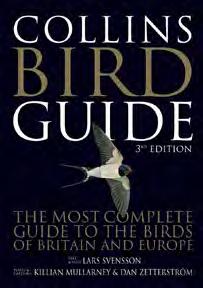

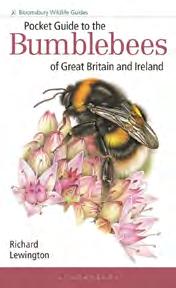



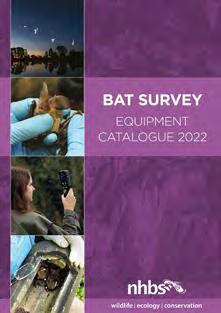
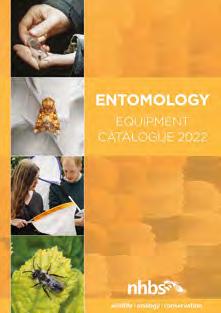
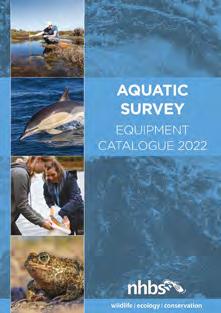



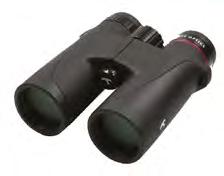
#255852 HB £19.99* £29.99 #258538 PB £19.99 #245239 £83.69* £99.98 #251866 £359.00* £399.00 #255963 £209.00 #255223 £159.95 NHBS Nest Box Camera Kit Kite Falco Binoculars Echo Meter Touch 2 - Android Browning Strike Force HD Pro X #258251 PB £10.99 #258716 PB £8.99 #258797 Spiralbound £14.99 Serving conservation since 1985 Available from: www.nhbs.com | 01803 865913 customer.services@nhbs.com | +44(0)1803 865913 | NHBS, 1-6 The Stables, Ford Road, Totnes, Devon, TQ9 5LE, UK We sell a huge selection of books and equipment items for: Bat survey | Mammal survey | Amphibian survey | Botanical survey | Aquatic ecology | Habitat management | Practical conservation And more... Due Feb 2023 *Offer prices correct at time of printing Browse copies of our 2022 subject specific catalogues online







* Terms & Conditions Cheapest night free, subject to availability and excludes peak and key dates Wivenhoe House Quote ‘Essex Wildlife Trust’ whilst booking and get a free bottle of prosecco in your room! Enjoy our Four Nights for the Price of Three Staycations*, a stone’s throw from Constable Country. Near to the pretty quayside village of Wivenhoe, and minutes from Britain’s oldest recorded town, Colchester, Wivenhoe House offers the ideal base to explore both Essex and Suffolk. Sea, shopping and sightseeing are all within easy reach of Wivenhoe House, whether you are a couple searching for a romantic break or a family seeking an ultimate adventure, we have something to offer. Wivenhoe Park, Essex, CO4 3FA | +44 (0)1206 863666 info@wivenhoehouse.co.uk | wivenhoehouse.co.uk Four Nights for the Price of Three Staycation Scan to book
Scan to find your nearest centre.

Christmas Gifts







for All
Visit one of our Nature Discovery Centres this Christmas for all your shopping needs, helping to support wildlife whilst you shop!


Love Essex • Love Wildlife Registered Charity No. 210065
WorkingTogether for wil dlife

w 16WILD Winter 2022 Working together for wildlife |
Introducing the Essex Local Nature Partnership
The Essex Local Nature Partnership (LNP) is an alliance of organisations in Essex who have committed to working together over the next decade to tackle the climate crisis and the ecological crisis. The LNP is the first time that these organisations have come together in a coordinated way at such scale, which we hope will prove to be a watershed moment in the future of our county. And the timing couldn’t be better. The magnitude of the challenges ahead require us to operate at scale and with a new sense of urgency and ambition. The clock is ticking. The time really is now.
Coordinated by Essex County Council, the LNP currently includes (in alphabetical order): Braintree District Council, Country Land and Business Association, Environment Agency, Essex Association of Local Councils, Essex Climate Action Commission, Essex Cultural Diversity Project, Essex Developers Forum, Essex Highways, Essex Wellbeing Service, Essex Wildlife Trust, Forestry England, Ground Control, National Farmers Union, Natural England, NHS Partnerships, Place Services, RSPB, Rural Communities Council for Essex, Southend-on-Sea City Council, The Conservation Volunteers, Thurrock Council, Whirledge & Nott, Wilderness Foundation, Woodland Trust, and Young Essex Assembly. We’re a big group!

17 WILD Winter 2022 Working together for wildlife |
Welcome to the Local Nature Partnership

Plans for the Local Nature Partnership (LNP) were drawn up in 2021 and began in earnest in March 2022 with the appointment of Dr Simon Lyster, an experienced conservationist and environmental leader (as well as a contributor to WILD Magazine), as the Chair of the LNP Board. Simon was Director General of The Wildlife Trusts from 1995-2003 and has held many senior national roles, making him the ideal Chair. Simon was soon joined by Helena Taylor as the LNP’s Coordinator. Simon and Helena, who was formerly with The Conservation Volunteers, are passionate about the nature recovery opportunities in Essex and form the core team.
The need for a Local Nature Partnership in Essex
It is well reported that the UK is one of the most nature depleted countries on earth. According to the Biodiversity Intactness Index, the UK ranks 189th out of 218 countries. Essex, meanwhile, is by many measures the most developed county in the UK.
The mission of the LNP is to reverse the decline of nature in Essex. “It won’t be easy, but the opportunities to succeed in our mission are greater than ever, and I am confident we can do it”, says Simon. “The key is partnership, and we have brought together all the relevant interests, from businesses to farmers to NGOs, to work together for change, and they are all eager to engage and help”.

With new incentives planned to reward nature-friendly farming, the 2021 Environment Act imposing new duties to enhance biodiversity, and many Essex communities already active in nature recovery and combating climate change, the omens are promising.
“Scale is critical”, says Simon. “We have asked organisations to pool their expertise, resources, and influence in order to achieve impact on a scale that just wouldn’t be possible individually. I am particularly excited that a group of 40-50 farmers in the upper Blackwater catchment have already come together, backed by water companies and local authorities, to deliver nature improvements at scale in their part of Essex.”
The coming together of organisations to fight a common cause has been a real shift in recent times, not least the alliance of conservation charities in response to the Government’s policy position in September, under the banner of the Defend Nature campaign. “Working in partnership is the only way we are going to tackle the big problems in the future,” argues Dr Andrew Impey, Chief Executive of Essex Wildlife Trust. “The need for a Local Nature Partnership is greater than ever.”
“The Local Nature Partnership has four ambitious targets for 2030 which guide our work, around which all organisations are coalescing,” explains Helena Taylor, Local Nature Partnership Coordinator. “These will be the

Working together for wildlife
w 18WILD Winter 2022 |
Hall
European eel
The Local Nature Partnership had their first face to face session at Abbotts
2 3 4
Targets
The Local Nature Partnership has four main targets over the next decade:


1Increase Natural Green Infrastructure coverage from 14% to 25% in Essex by 2030.
50% of farmland in Essex to adopt sustainable stewardship practices by 2030.
1 in 4 people taking action for wildlife by 2030.
Access to high quality green space for all by 2030.
Bringing together our expertise
The LNP is governed by the LNP Board, which consists of representatives from agriculture, development, local government, conservation organisations, community groups, health organisations, youth groups and businesses. “The LNP Board met for the first time in person in July 2022 at Abbotts Hall,” says Helena, “and the energy and enthusiasm was fantastic. It bodes well for the future.” The Board oversees four Working Groups, which are in turn led by different organisations. Among the most critical of these Working Groups is the one charged with leading on the creation of the county’s Local Nature Recovery Strategy, which is a statutory requirement of the Environment Act 2021.
Local Nature Recovery Strategy (LNRS) Working Group

The LNRS working group brings together the knowledge and skills to create a strategy that has the best possible outcomes for nature in Essex. The Working Group is Chaired by Tim Simpson, Green Infrastructure and SuDs Manager at Essex County Council, as the LNRS will be delivered by Essex County Council on behalf of Greater Essex, which includes Southend-on-Sea City Council and Thurrock Council – authorities which are represented on the group.
What is the Local Nature Recovery Strategy?
Tim explains: “The LNRS will map existing spaces for nature, and future opportunities for habitat creation and restoration, thereby providing a blueprint for nature’s recovery and identifying the actions needed
to drive change on the ground. Our Essex LNRS will form part of an England-wide Nature Recovery Network, so every county is going through an equivalent process. We are currently awaiting further guidance from the Department for Environment, Food & Rural Affairs to progress the LNRS further, and then we’ll really be getting some momentum.”
Watch out for opportunities to find out about and contribute to the Essex LNRS.
19 WILD Winter 2022| Working together for wildlife
Skylark
Badger
Biodiversity Net Gain (BNG) Working Group
The BNG Working Group is preparing Essex for Biodiversity Net Gain at county level. Biodiversity Net Gain is the forthcoming requirement (enshrined in the Environment Act 2021 but yet-to-be mandated) for the development of land to achieve a minimum of 10% gain for wildlife, thereby leaving the natural environment in a measurably better state than it was beforehand. The Working Group is Chaired by Emma Goldings, Chairperson of Essex Planners Officers Association (EPOA) and Head of Planning at Braintree District Council.
“We are learning from examples of BNG across the UK, from businesses in the private sector to district authorities who are beginning to include BNG in local plans,” says Emma. The group is currently working on a Guidance Pack for Local Planning Authorities, which outlines what BNG is, how it works, current mandatory elements of BNG and how it might impact a planning officer, a developer, or a landowner.
If you are interested in receiving the BNG Guidance Pack, please get in touch.
Community Engagement Working Group
The Community Engagement Working Group is formed of key organisations who lead on engagement with nature across Essex. The Working Group is Chaired by Rich Yates, Director of Engagement at Essex Wildlife Trust, and the Vice Chair is Jane Houghton, Project Manager at Natural England. “We’re tasked with delivering against the LNP’s two ‘people’ targets,” Rich tells us. “We want access to high quality green space for all and 1 in 4 people taking action for wildlife by 2030.” The group is currently creating baseline studies for both targets, exploring potential funding opportunities to support their goals moving forward, and developing delivery plans.
The group have recently been learning from community groups who are already active, including PACE (Practical Actions for Climate and Environment), a local community action group in Manningtree, Chaired by former Trust CEO John Hall. PACE work together to address the climate crisis and support the natural environment.

If you are a community group who want to tell us about your work or need support, please get in touch.
Agricultural Working Group
The Agricultural Working Group is tasked with supporting the delivery of the LNP’s two ‘space’ targets: increasing Natural Green Infrastructure from 14% to 25% in Essex by 2030 and supporting 50% of farms in Essex to be using sustainable practices by 2030. The group is Chaired by Hannah Buckenham, Head of Habitat Database at Whirledge & Nott.
“With the help of organisations including the National Farmers Union, the Country Land and Business Association, and Natural England, we will be connecting with farmers and landowners across Essex to understand the barriers to sustainable land management, and identify any support that’s currently missing,” says Hannah. “We know that farmers care deeply about the natural world and want to be sustainable, but it’s not always straightforward. We want to work with them to make it as easy as possible.”

If you’re a farmer or landowner and want to work with us, get in touch.
Find out more
Essex Wildlife Trust is committed to working through the Local Nature Partnership, so we will keep you updated as members of the Trust. However, if you want to know more, or contact either the Chair, the Coordinator, or any of the Working Groups, email nature.partnership@essex.gov.uk. You can also sign up for our quarterly e-newsletter, which reports on the progress of the four Working Groups, events, important announcements, and much more.
20WILD Winter 2022 |
Working together for wildlife
Photo: Chris Gomersall/2020VISION
Inspirational supporters
The Essex I grew up in was a very different place from the county we know today. In the mid-fifties there were fewer houses, a lot more green fields, much less traffic and vastly more wildlife. Even in the 1960s, I remember the dawn chorus being so loud and prolonged that it could even wake me early in the morning as a comatose teenager after a night on the tiles. There were so many birds it was pretty well impossible to identify the individual singers.
Now, over fifty years later, I no longer indulge in late nights, nor do I get awakened by a deafening avian choir in the wee small hours. A few weeks ago, I listened attentively to the dawn chorus and realised that there were less than a dozen individual participants: one wren, two blackbirds, one robin and a couple of great tits, plus the usual collared doves and wood pigeons.
My husband, Greg, grew up in New Zealand where, he says, bird numbers have been decimated by rats and other predators. Most indigenous bird species there cannot fly, largely because there were originally no indigenous predatory mammals to make flight necessary. That situation has sadly changed.

Greg and I both agree that we want to help wildlife of all kinds to regain the foothold to which it is entitled, and to restore the long-lost balance between humans and the natural world. And the best place to start is on our own doorstep.
Since our wishes tally wholeheartedly with the aims of the Essex Wildlife Trust, and since I have lived in Essex since childhood and Greg for over 35 years, we thought we could do no better than to leave a small legacy to the Trust. We hope that, in some way, this may be used to help towards redressing the losses the natural world has experienced during the course of the last 60 years.
Ours may not be a big legacy, but if everyone who feels as we do were to leave a small amount, the tide of wildlife deterioration might be able to be turned.

Jenny and Greg Curtis-Beard Thorpe-le-Soken, Essex
For more details on leaving a gift in your Will, call our Legacy team on 01621 862987, visit www.essexwt.org. uk/gifts-in-wills or scan the QR code.

Inspirational supporters
Greg and Jenny
21 WILD Winter 2022 | 2022|
Mythbusters Nature

Once you dive into the wonderful world of nature, you will quickly learn that our ecosystem is extraordinary and there is always a new species to discover or a new spectacle to experience. But on your unending journey of discovery, watch out for nature myths! Often widespread and passed down from generation to generation, there are plenty of nature misconceptions out there. We’ve picked three well-believed nature ‘truths’. Do you know which ones are fact and which are fiction?
Bees always die when they sting you
Have you ever been stung by a bee? Many people believe that once a bee stings you, it dies. This can leave you feeling unexpectedly sorry for the tiny but mighty creature doing the stinging.

Well not to fear! Out of over 250 species of bees that live in the UK, only one species actually dies after it stings you – the European honeybee. On top of that, it is only female bees that have stingers. If threatened, the vast majority of bees will simply sting you and then retract their stinger and bumble off to the next flower.
Moles are blind
Small yet incredibly powerful, moles spend a huge proportion of their time burrowing and digging around underground. As a result, moles are amongst some of the least-studied mammals in the country, and therefore often misunderstood.
A great example of this is the idea that moles are blind or that they don’t even have eyes. This is in fact… a myth. Always below our feet, in small tunnels and surrounded by dark soil, moles don’t have a huge need for exceptionally good eyesight. They definitely do have eyes though and although they are believed to be colourblind and near-sighted, they are particularly good at detecting light. This is a very useful tool for determining when they might have dug the wrong way!

nature mythbusters 22WILD Winter 2022 |
We all know this old wives’ tale, but can we really trust it? The answer is yes… for the most part. This commonly-used saying is only true within mid-latitude areas, which includes the UK, where weather systems predominantly travel from west to east. But how does it work?
You might know that high pressure means clear skies. Well, it also means more highly concentrated particles which are very effective at scattering the blue light within the sun’s rays. This leaves the red and orange
light to take centre stage. Therefore, a high-pressure system is indicated by a very red sky.
If the red sky is seen at sunset (to the west) then we know the high-pressure system is on its way to us, bringing gloriously clear skies. However, if we have a red sky in the morning (to the east) then we know the high-pressure system has passed us, leaving space for the low-pressure system to swoop in and bring us a drizzly, grey day.

nature mythbusters 23 WILD Winter 2022|
Lone oak photo: Jon Hawkins Surrey Hills Photography, Honeybee photo: Jon Hawkins Surrey Hills Photography.
Red sky at night, shepherd’s delight Red sky in the morning, shepherd’s warning
If ever there was a site to capture the phrase ‘living landscape’, the Naze is it. This is a place of contrast: an area rich in history, steeped in tradition, and yet, its geography is ever-changing, constantly facing the force of the powerful sea.

w

Nature Discovery Centre The Naze
The Naze nature discovery centre
The Naze cliffs photo: jayfish.
What to look out for this winter at the Naze

Common seal

Lounging lazily upon Essex’s marshy banks, these adored mammals may occasionally be spotted poking their curious heads out of the water.
Kestrel
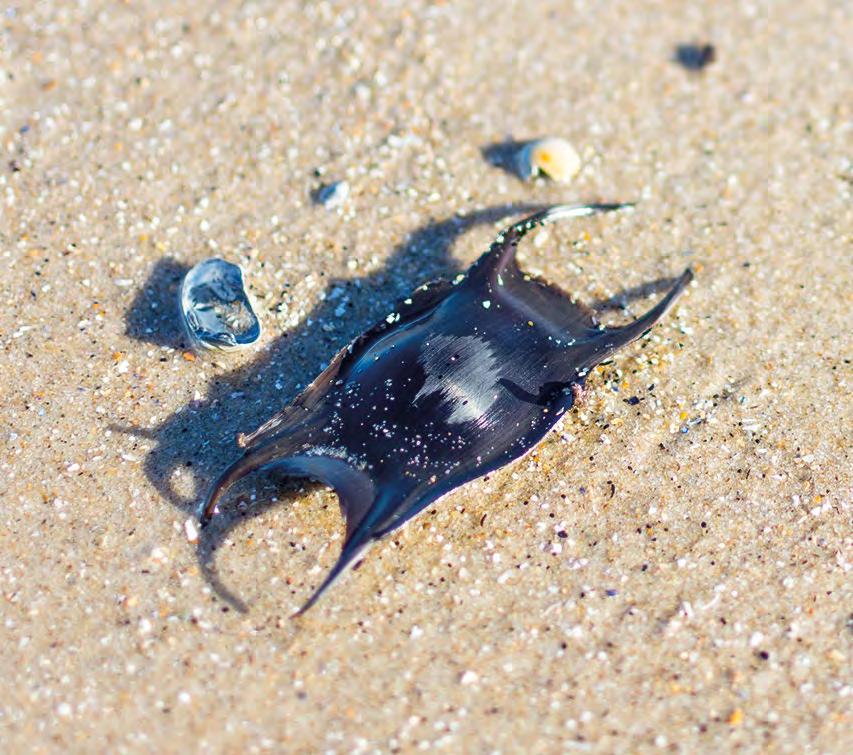
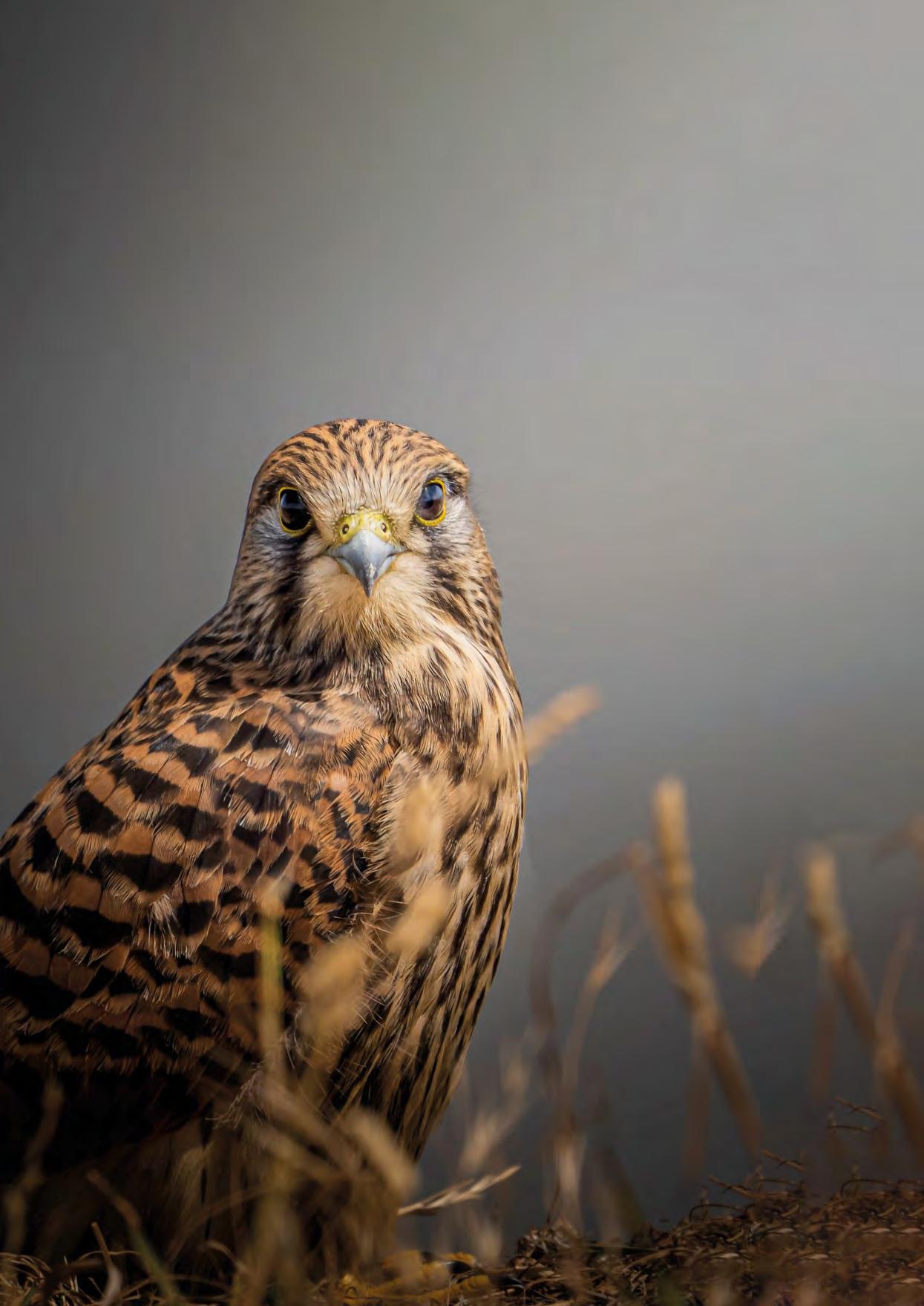
The ultimate hovering bird of prey, watch this graceful predator hunting amongst the tall, towering cliffs.
squat, these little birds are the bandits of the beach. With striking mask-like markings and a black breast, they are carried by bright orange legs.
Billie’s facts
The Naze nature discovery centre
Address: Old Hall Lane, Walton-on-the-Naze, CO14 8LE.
Access: Situated within land owned and managed by Tendring District Council. Open daily, parking is pay- and-display. Walks include steep stairs down to the beach or gentle paths around the grassland and woodland.
Dogs: Dogs are permitted on the site.
Naze nature discovery centre
The
Kestrel photo: @liam_london_wild, ringed plover photo: Tom Marshall, common seal photo: Terry Whittaker2020VISION.
The Naze derives from the Old English ‘Naes’, meaning nose. This coastal headland stretches northwards from the town of Walton-on-theNaze and is the geographical ‘nose’ of Essex as the most easterly point of the county. However, Walton was not always a coastal region. Every year, nearly two metres of land is lost to coastal erosion. Over time, the medieval farming village of Walton was subjected to the force of the nearby waters. As centuries passed, much of Walton’s historic landscape has submerged underwater, nine miles out to sea.
The present-day Naze has defining features that make this a tourist and educational hotspot. The Naze Tower, standing at an impressive 86 feet, is the landmark of this coastal community. The Grade II listed building with unique architecture is a reminder of the military history of the area. Since 1720, this towering structure has watched over thousands of passing ships as they navigate the North Sea and aided throughout the World Wars.

Just as you stretch your eyes upwards to appreciate the altitude of the Naze Tower, you may also look down towards the sea, and be captivated at the sight of immense cliffs, sculpted by the powerful waves below. Not only are they an astounding sight of natural beauty, but they too are rich in history. Formed from 54-million-year-old London clay and 2-million-year-old Red Crag, these cliffs are geographical dinosaurs. Embedded within their rocky formation hides thousands of fossils, lying dormant until they are discovered by eagle-eyed passersby.

Relics of the past are often revealed by the retreating tide. Sharks’ teeth and fossilised wood are among the most common. They are dated around 55 million years old, a time when the shoreline was similar to present-day Indonesia with mangrove and rainforest. In 2019, a young fossil seeker discovered a prehistoric megalodon tooth, the biggest fish that lived, on this very beach. Members of the
public are welcome to scour the shore but you must check the tide beforehand, as the incoming tide can creep up on engrossed fossil hunters.
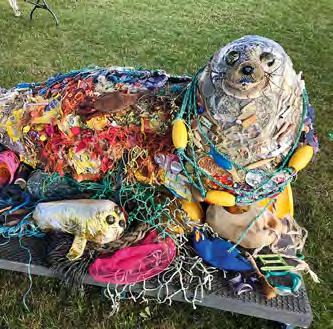
Many say that the Naze has three defining aspects: the Naze Tower, world-renowned fossils, and its battle against coastal erosion. Yet, the Trust believes there is a fourth defining feature, marked by the presence of The Naze Nature Discovery Centre, and that is, the fantastic wildlife that can be witnessed. Since 2016, the Nature Discovery Centre has stood as a gateway for the local community to discover nature. The building has its own interesting architecture, featuring a ‘living’ roof – a blanket of flowering plants – that blend this building into the landscape. The roof changes colour seasonally, boasting vivid greens in the summer and turning a coppery autumnal red when the colder weather appears.

When visiting our Nature Discovery Centre, keep an eye out for ‘Meg’ the megalodon shark, although she is quite unmissable. You can also visit Poly the seal and her pup Nurdle, named after the polythene and microplastic sadly found on coastal beaches. The seals were constructed from plastic pollution found during monthly beach cleans by Trust staff and volunteers. Poly acts as an educational tool to demonstrate how marine pollution threatens wildlife.
If you would like to help keep the coastline clean at the Naze, there are regular beach cleans open to the public.
The Naze nature discovery centre 26WILD Winter 2022 |
‘Relics of the past are often revealed by the retreating tide. Sharks’ teeth and fossilised wood are among the most common.’
The Naze Tower
Megalodon tooth
Cliffs at The Naze
Poly the seal and her pup Nurdle
As the cold creeps in, the nearby John Weston nature reserve is bursting with resilient rough grassland, hawthorn berries and bramble thickets. For many birds that prepare for a migratory journey to tropical lands, this is the perfect pitstop. Willow warbler, spotted and pied flycatcher, ring ouzel or even a tiny firecrest, with its blazing yellow head stripe, can be seen here in autumn months.
In winter, witness the iconic dark-bellied brent geese lining the foreshore, recuperating after their transatlantic journey from Arctic Siberia. Sanderling scamper like clockwork toys along the beach, among turnstone and ringed plover. Overhead, short-eared owl, merlin and marsh harriers hunt the saltmarsh towards Stone Point, while Hamford Water, the Naze’s coastal neighbour, plays host to thousands of wildfowl and waders.
Follow the Naze on Facebook for up-to-date events, fossil sightings and nature spotting: www.facebook.com/ EWTNaze

Spring is a season of arrivals and departures, and possible rarities, when we await the first chiffchaff, wheatear and cuckoo of the year. A blue rock thrush, the national bird of Malta, stirred excitement when it was discovered on the undercliff this May. The crumbling cliffs provide nesting and resting habitats for many bird species, including a small colony of sand martin and hovering kestrels. The surrounding islands of the Walton Backwaters offer nesting opportunities for little, common, and sandwich terns, and Mediterranean gull. In the summer, these can be seen commuting across
the beach with food for their young. For insect lovers, venture through John Weston nature reserve, tucked away to the north of the site, and you may spot willow emerald damselfly or southern migrant hawker dragonflies zooming rapidly along the water’s surface.
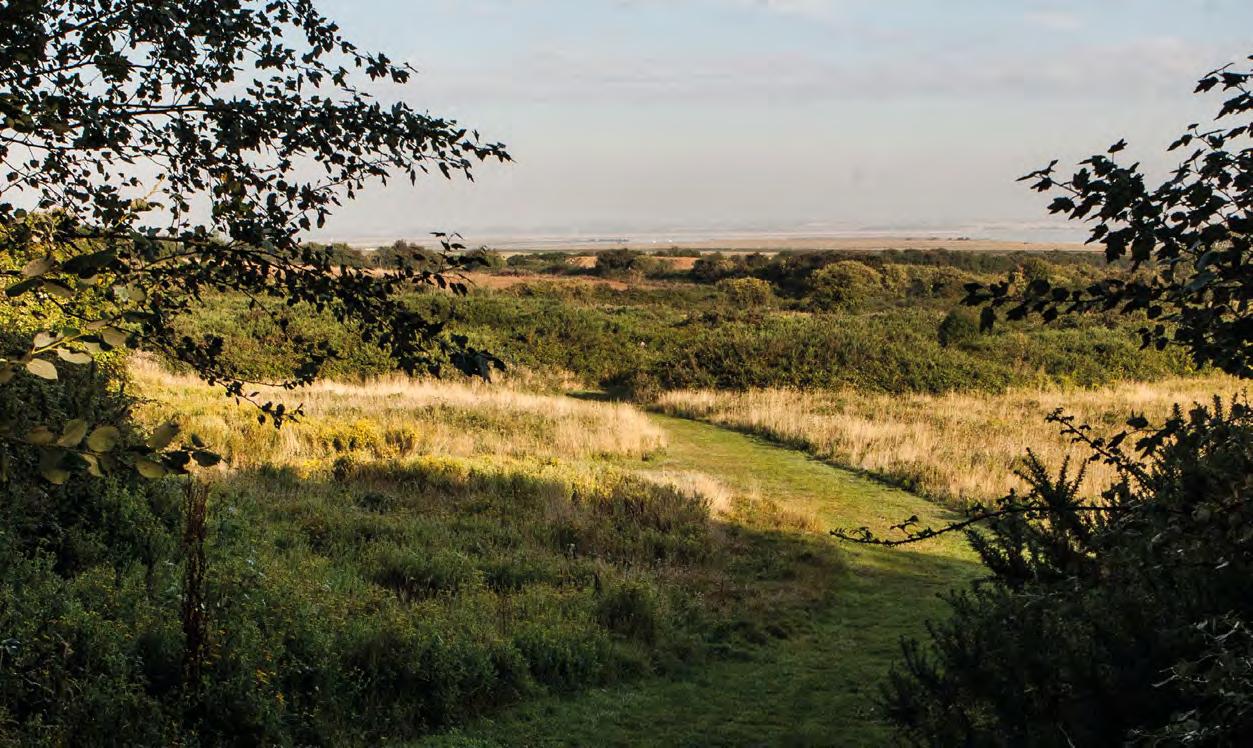
Hamford Water is home to a significant colony of common seals, with pups arriving in June and July. Look closely and you might witness an unusual phenomenon – their orange hue. Sliding around on the muddy banks of saltmarsh and estuaries changes their fur from grey to this bright colour because the salty mud contains iron oxide (just like rust) and this rubs off on the seals. It is completely harmless to the seals, but makes them an iconic Essex species.
With cliffs sculpted by the ocean, military landmarks erected from the past, and a Nature Discovery Centre designed by wildlife lovers, this site is a must-visit for any season. You never know what hidden treasures you may discover within this dynamic landscape, or what magical wildlife you may encounter.
Winter events at The
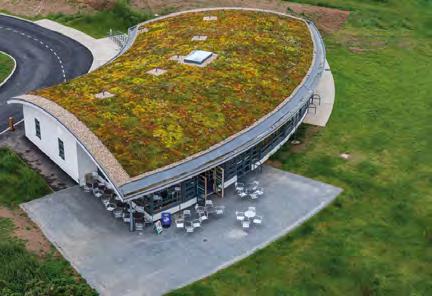
Naze
Nature Discovery Centre
Christmas Celebration
Children can receive gifts from Santa in his grotto and create festive decorations with natural materials. from Saturday 17 - Sunday 18 December.
Wreath-making Workshops for adults will be running over the festive period.
Winter guided walks
A winter programme of guided walks covering geology, history and birdwatching can be found on the Trust website.
27 WILD Winter 2022 | The Naze nature discovery centre
The Naze Nature Discovery Centre photo: Tendring District Council
John Weston nature reserve photo: Peter Bowden
Sanderling photo: Chris Gomersall2020VISION
Save Our Species
The rhythmic song of the nightingale and the soft purring of a turtle dove are well documented throughout history – inspiring poets, authors and musicians alike. For many people, the mesmerising notes of these iconic birds evoke happy childhood memories of long, lazy spring and summer days.

However, these amazing birds are in serious trouble...
A staggering 98% of turtle doves and 92% of nightingales have been lost in the UK since 1970.
We are fortunate to protect strongholds for these birds - you can hear the crescendos of nightingales at Fingringhoe Wick in May, and the purring of turtle doves at Wrabness in summer months.
With 41% of the UK’s species in decline and 15% at risk of extinction, we are in danger of losing some of our treasured wildlife forever.
Essex Wildlife Trust has brought back species on the brink of extinction before. With your help, we can do it again.
To ensure our wildlife has somewhere safe to shelter and thrive, our nature reserves must be a beacon of hope for wildlife, providing relief and refuge and vibrant mosaic habitats for wildlife to nest, forage and breed.
This Christmas, can you help us protect our much-loved species, so they remain a part of our county’s natural heritage?
£5 could fund three metres of new hedgerow, offering vital nesting habitat for birds and mammals.
£10 could help revitalise wildflower meadows, and help bees, butterflies and other pollinators thrive.
£20 could help us purchase tools to manage scrub mosaics, providing more breeding and feeding Opportunities for wildlife.
Love Essex • Love Wildlife
We have limited resources to donate via post and telephone at the
to donate is by text or online. We apologise to our regular supporters
phone or post are the only means available to you, you can contact
Thank you for your support.
Texts will cost the donation amount plus one standard network rate message, and you’ll be opting into hearing more from us. If you would like to donate but don’t wish to hear more from us, please text SPECIESNOINFO with your donation amount to 70085 instead. Registered Charity No. 210065.
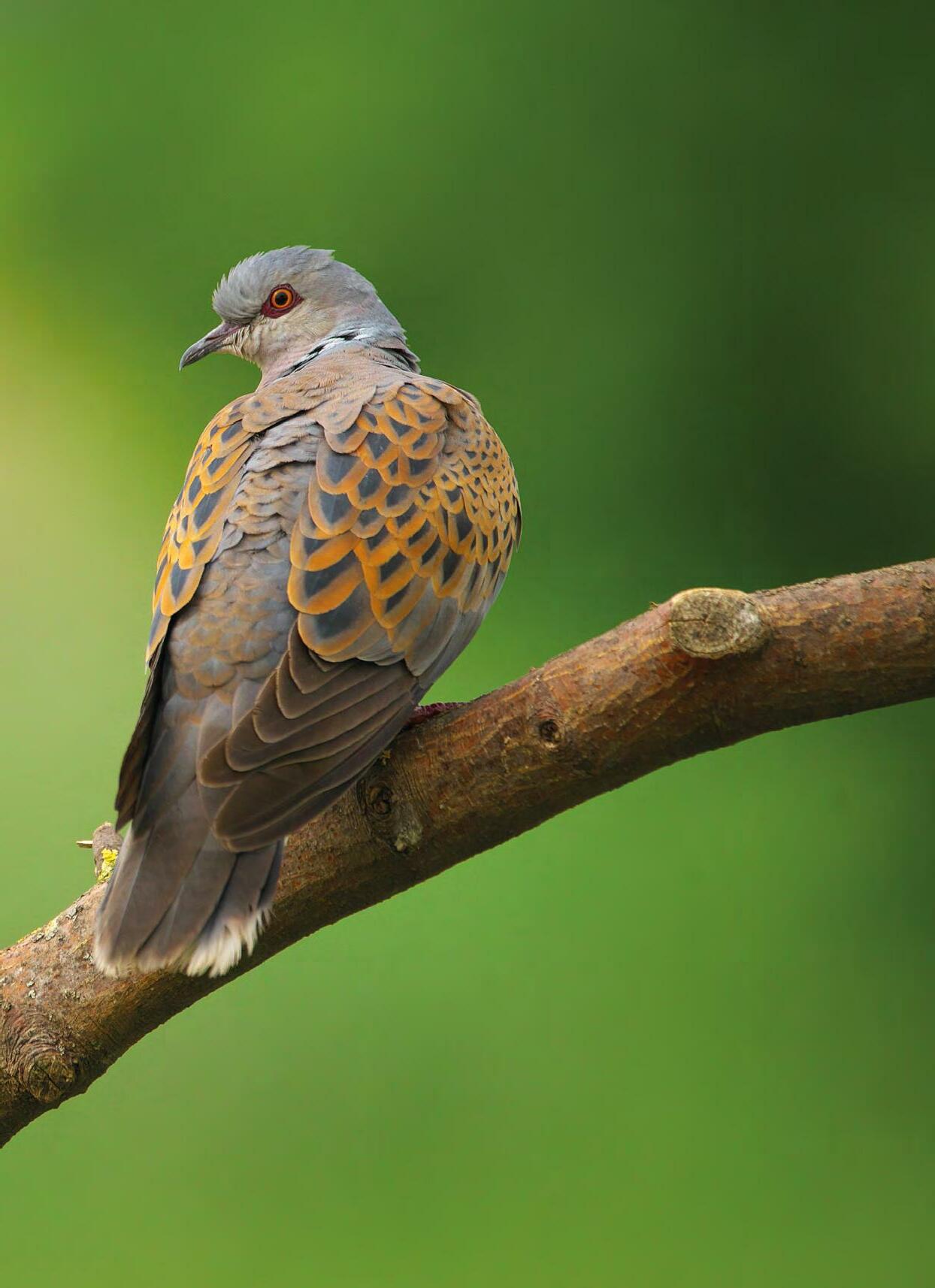
so the best way
these restrictions.
your donation to
Great Wigborough, CO5 7RZ.
moment,
for
If
us or send
Save Our Species Appeal, Essex Wildlife Trust, Abbotts Hall,
DONATE ONLINE www.essexwt.org.uk/save-our-species To 70085 to donate £5 TEXT To 70085 to donate £10 SPECIES 10 TEXT To 70085 to donate £20 SPECIES 20 TEXT SPECIES 5 Please consider helping us make a real difference to wildlife. All money raised will help Essex Wildlife Trust to protect the iconic species of Essex and the habitats they live in.
Photo: Turtle dove.
Winter Wildlife Gardening
Our gardens all but go to sleep in winter, as plants become dormant and most species are overwintering, but there are still ways to help your garden wildlife.
Kate Bradbury is passionate about wildlifefriendly gardening and the author of Wildlife Gardening for Everyone and Everything in association with The Wildlife Trusts.


Hedgehogs and amphibians may be tucked beneath a large pile of leaves or in your compost heap, while insects may be sheltering beneath tree bark, in the folds of spent leaves and
seedheads, or amongst leaf litter. Avoid disturbing these habitats until mid-spring as any interruptions could cost valuable energy that isn’t easy to replenish at this time of year; insects may also be vulnerable to fungal diseases if exposed to damp conditions.
Indeed, the best thing you can do for most wildlife at this time of year is to not garden at all! Leave plants in borders to rot down into themselves, avoid clearing leaf litter from your garden’s edges (but do sweep leaves off paths and the lawn), and leave habitats such as log piles and compost heaps intact. If you have a meadow or other area of long grass, leave a ‘buffer zone’ uncut throughout winter, so caterpillars, beetles and other invertebrates can shelter in the thatch.
Of course, not all animals hibernate. Birds battle through the short days and cold nights, searching for food that’s often hard to come by. If you have fruit trees, like crab apples, let windfall fruit remain on the
Winter wildlife gardening
BY HANNAH BAILEY, PHOTO © SARAH CUTTLE
ground so thrushes such as redwings and fieldfares can help themselves. If the ground isn’t frozen, you can add to your collection of fruit and berrying trees. Now’s the time to buy bare-root trees and shrubs — hawthorn, rowan, holly, apples, crab apples, and pyracantha all produce fruit loved by birds, while birches and alder, along with plants such as Verbena bonariensis, lavender and teasels, offer seeds for a wide range of smaller species.
water, but by regularly topping up your bird bath you will also help birds to clean their feathers and regulate their temperature, vital on cold winter nights.
ILLUSTRATION
Filling supplementary feeders benefits smaller species like tits, which need to feed almost constantly in the daylight hours. Calorie-rich food such as fat balls, sunflower hearts and peanuts gives them the energy they need to shiver to keep warm at night. Leave scraps of seed at the back of borders for ground-feeding species like wrens. And don’t forget water — not only do bird baths provide drinking
Do make sure you keep bird baths and feeders clean, as the number and variety of birds visiting them can spread diseases. Regular cleaning can help keep your garden birds healthy.
Get more wildlife-friendly gardening tips at wildlifetrusts.org/gardening

31 WILD Winter 2022|
Y our step-by-step guide t o making a bird boot.
During the winter, birds seek shelter in gardens from the harsher countryside environment, especially if there is consistent availability of high-energy food such as fat balls. Some birds, like wrens and house sparrows, use garden nest boxes as winter roost sites. They will often use the same box to nest in the spring. Other birds, such as tits, begin searching for nesting sites towards the end of winter in February. You can help birds survive the winter months and raise their brood in the spring by building a bird box - or in this case, a bird boot!
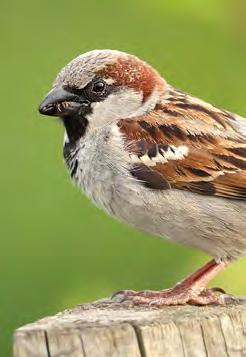
• An old walking boot • A wooden plank – we used a plank from an old pallet
What
you will need
• A saw • A pencil • A drill, drill bit and 8-10 screws (length dependent on thickness of wood and sole of boot) or hammer and 8-10 nails
• A tape measure – if you want to be precise
Start
Gather all your materials. You can use a drill and screws but nails and a hammer work just as well.
Step 3
Draw around the sole of the boot on the back of the panel and mark with the pencil where you want to position your screws or nails. This will make it easier to fix the boot in the right place.
Step 1
Using a saw, cut your wood into a back panel and two shorter roof panels. You can use the length of your old boot to determine the length of the back panel.
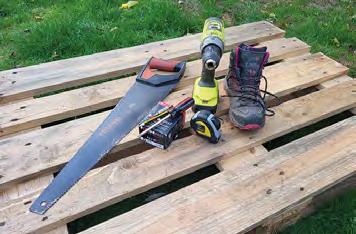



Step 4
Fix the boot onto the back panel. one screw at the top/ heel of the boot and two at the toe of the boot.
Step 2
Attach the two roof panels to the top of the back panel using either the drill or hammer. If there is a gap between the two panels at the ridge of the roof, secure with a screw.

Step 5

Just like hanging a picture frame on your wall, attach your boot box to a wall, fence or tree by hanging it from a hook or screw. Between 2-4 metres is suitable for most garden birds.
If you make your own bird boot, we’d love to see it, send your pictures to magazine@essexwt.org.uk.
House sparrow
| 32WILD Winter 2022 HOW TO HELP WILDLIFE

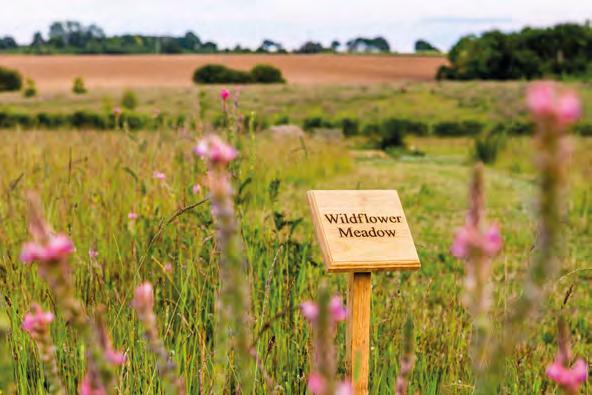



Love Essex • Love Wildlife Registered Charity No. 210065 Discover upcoming opportunities at www.essexwt.org.uk/volunteering A study of Wildlife Trust volunteers showed that 95% of participants with low mental wellbeing at the start of volunteering reported an improvement in six weeks. 01245 806332 info@oldparkmeadow.co.uk @oldparkmeadow @OldParkMeadow Coppice Lane, North End, Between Chelmsford & Great Dunmow, Essex, CM6 3PL Burial & Ash Interments, Funerals, Services and Wakes Memorial Services and Celebrations of Life Adaptable and completely personalised service from memorials to music. Reserving a plot in advance is also possible. Assurance of a caring and compassionate experience. OLD PARK MEADOW Natural Burial Ground T1358-90x133point5mm-EssexWildlifeTrust.indd 1 30/08/2022 13:10
Winter wellbeing
As winter settles in, the long days of light evenings and gentle warm breezes are behind us. For some, colder weather draws us indoors, shutting the door on nature this season. But studies have proven the countless benefits that spending time in nature has upon us, physically and mentally. From improved fitness and a slower heart rate, to reduced stress and increased joy, it is important that we don’t let the colder climate keep us from reaping the benefits that wandering through winter has to offer. Hear the gusts of wind, rattling upon your window? It’s nature’s knock, inviting you back outside.
Connecting with nature in winter is more important than ever. Darker days can dampen our moods, but it is only a reminder to make the most of the light. Whether you are with family, friends or spending time on your own, winter reveals new and exciting wildlife, all to be enjoyed on those shorter days.
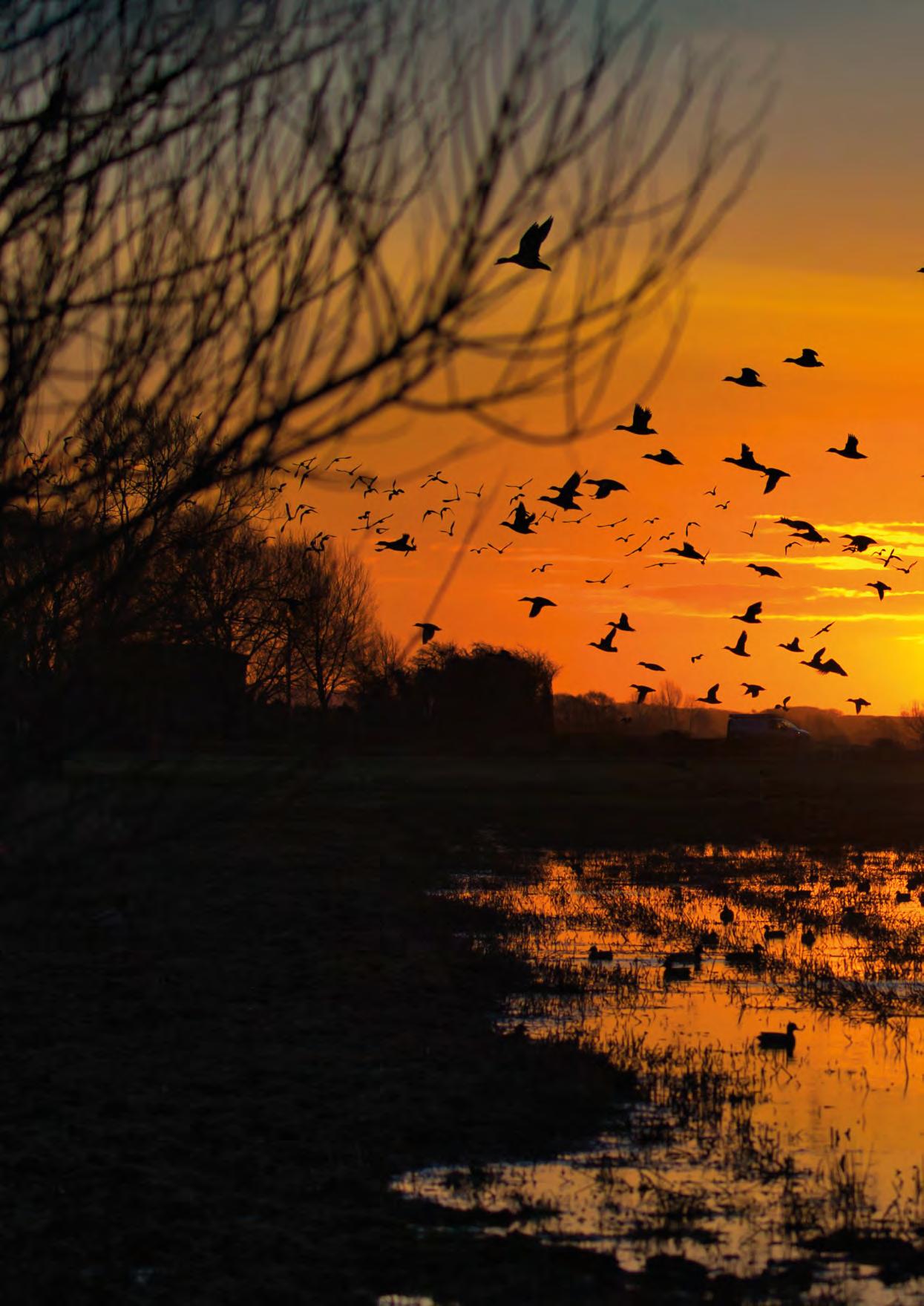
Go foraging for fungi by spotting bright colours and unusual textures amongst the green and brown hues of woodland landscapes. Witness winter migrants like the dark-bellied brent geese, soaring above in an arrowhead display. When frost arrives, admire the way it reveals the intricate veins and patterns on a leaf, and listen to the glimmering grass crunching as you stroll.
For many, winter can be a time of loneliness. Find solace in the season by connecting with the wild spaces around you. If you can, why not join a local walking group, or volunteer with us? Helping nature, even on colder days, is a rewarding challenge. Nature can give us a purpose; by nurturing nature, you are taking steps towards nurturing yourself.
Winter Wellbeing 34WILD Winter 2022 |
From 25 December - 5 January, take part in our festive nature challenge, 12 Days Wild. Let’s make this winter a ‘wild’ one...
1
Go on a winter walk
Winter is brimming with enchanting sights and majestic spectacles. Pull on your biggest coat, lace up your waterproof boots and head off into your local patch of wildness. Keep your eyes peeled and your ears on high alert for wild beasts! Make sure you look in every direction, sometimes the most mesmerizing moments take you by surprise. You never know what you will discover just around the corner.
3
Photograph the frost
What’s more magical than a crispy leaf, intricately detailed tree bark or ripe winter berries dusted with sparkling frost? There’s no need for expensive equipment, anyone with a smartphone can be a winter wilderness photographer! Head outdoors and snap a captivating close-up or a perfect ‘paw-trait’. Share your favourite snaps with us on social media by tagging Essex Wildlife Trust and using #12DaysWild
5
Watch the sunrise
As the days draw shorter, winter can become a dark time. Grab every second of sunshine you can by watching the morning sunrise. Thankfully for those of us who like a lie in, from late December – early January you can catch the sunrise around 8 o’clock.

2
Make a wreath for birds
As the days get colder and frost starts to coat our trees and hedgerows, garden birds can struggle to find food. So, why not treat your garden birds with a homemade wreath full of festive goodies for them to enjoy. You can make a garden wreath by twisting some twigs together, fastening into a ring shape with some garden wire and smearing over a paste of fatty goodness made from lard, birdseed, breadcrumbs and grated cheese... yum.
4
Wildlife window watch
Can’t find anything good on TV? Switch to the nature channel this winter. Grab a hot chocolate, bring a blanket and pull up a chair to watch wildlife live at your window. Record every animal and plant you can see. Why not compare it with a friend or neighbour or keep a diary and see how many species you can see in one week.
6
Investigate animal tracks
Turn detective this winter and go on the hunt for signs of your favourite wildlife. Animal tracks can be found anywhere from city parks or woodland paths or even your own garden. The chilly season is the perfect time to spot them as they stand out the best in snow and mud!
Go to www.wildlifetrusts.org/ identify-tracks to learn how to identify different animals.
35 WILD Winter 2022 | Winter Wellbeing
Sunrise over lake photo: Chris Hooper
8 12 Days Wild
Draw your favourite animal
Pull up a picture of your favourite animal and create your very own piece of wildlife art. You could draw a dragonfly, paint a puffin, collage a collared dove or even sculpt a scallop. Hang or display your new masterpiece with pride over the year ahead. You might even pick up a new hobby or notice something about your favourite animal that you’d never seen before.
9
Winter wildlife quiz
Test your friends and family’s nature knowledge with a wildlife quiz! Appoint yourself quizmaster and come up with the questions or search for the perfect quiz online.
Here’s a question to get you started: What is a group of hedgehogs called?

A) a herd B) an array C) a hoard (answer on the next page)
11
Search for wild mistletoe
Did you know that mistletoe is a parasite? This romantic plant associated with the festive period grows in the branches of trees and lives of their water and nutrients. Birds eat the white mistletoe berries and the seeds inside are spread to further tree branches in their droppings. Which means, you really can spot mistletoe anywhere! Lift your eyes to the skies and see how many bunches of mistletoe you can spot.
Learn something new
Did you know that Essex Wildlife Trust has a YouTube channel? We have over 360 videos about wildlife for you to enjoy. Check out our #EssexWildlifeTV playlist to learn about hundreds of different species and spectacles. Perfect for a rainy day!
10
Pond prep
The best thing you can do in your garden is provide wildlife with water. Ponds can come in many shapes and sizes, from a recycled plastic container to an old kitchen sink. If you’re thinking of creating an oasis for nature in your garden then you’ll need to collect rainwater to fill it with and what better time than over the rainy season!
12
Fungi forage
With over 15,000 species in the UK, fungi is fascinating! It makes up a whole kingdom by itself as it is neither a plant nor animal. From tiny toadstools to giant puffballs, there are so many species to spot and they can be found in most habitats. Just remember that although some mushrooms are delicious, others are poisonous so it’s best to leave them be!
Winter Wellbeing 36WILD Winter 2022 |
7
Spend more time outside
Whether you take a leisurely stroll through a nature reserve, cycle along country lanes, run through woodlands or take to the water for a refreshing dip, spending time in nature provides both physical and mental health benefits.

Use your senses
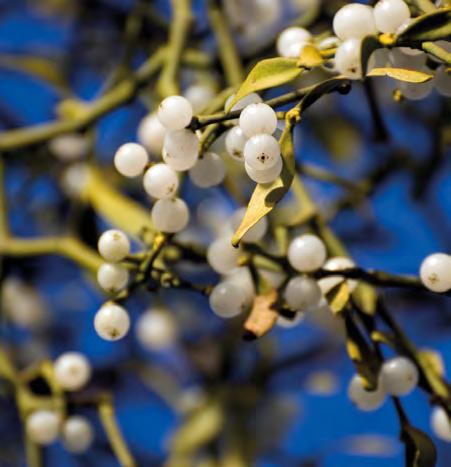
What can you hear rustling within the hedgerow? Can you smell the earthy tones of the woodland? What colours can you see bursting into life as seasons change? What does the coast really feel like? Touch the smooth or rocky pebbles as you hunt for fossils and shells.
Watch a wildlife webcam
Have you ever seen a barn owl lay eggs, and watched as the tiny chicks hatch? You can witness amazing nature experiences, wherever you are. Watch the playful and curious foxes and badgers as they come out to play, the soprano pipistrelle bats huddling together with their babies, and swallow chicks getting fed by doting parents.
Learn about nature
Whether you watch a nature documentary about faraway lands or read a book about the mysterious deep ocean, there are plenty of ways to connect with nature through learning. An easy option is listening to a podcast. The Trust’s podcast, The Wildlife Explorer, is available on all major podcast platforms. Learn about rare turtle doves, the mysteries of eels, how to make your garden wilder and much more.
Appreciate the seasons
Often, we think of the summer as the best time to get outside, but don’t forget about the other seasons. Here in Essex, we are lucky to experience the spectacle of seasonal change and encourage you to take note. Look closely at new species beginning to emerge and see how nature changes each month. Migratory species or hibernating creatures are special encounters throughout the year.
Take action for nature
A great way to connect with nature is by doing something for nature. Take part in local wildlife campaigns, from toad sightings to hedgehog-highway creating, or get busy making your garden wildlife-friendly for every season.
37 WILD Winter 2021| Section title here
WILD 2022 | Winter Wellbeing
As 2022 draws to a close, many of us will be making resolutions for the year ahead. If you enjoyed this year’s 12 Days Wild, think about embracing wildlife, all year round. Here are some ways you can connect with nature, whatever the weather:
B
Winter wildlife quiz answer:
Mistletoe photo: Zsuzsanna Bird
Sunrise photo: Jon Hawkins - Surrey Hills Photography
Essex Wildlife Trust’s Ambassadors

Francesca Chantry
It is a Thursday evening, the sun is setting and I am hiding, peaking over the other side of a fence into the overgrown woodland. To an outsider I would no doubt look like a mad woman, standing there motionless for over an hour, hyperaware of any rustling of the branches, and trying not to make a noise myself. I know they are awake, every now and then I can hear the tell-tale squeaking coming from their sett. For four months, I returned to this spot every week to set up my camera traps and from this, I had learnt their patterns. How at around 6pm each day the camera traps would capture a black and white streak peaking its way cautiously into the oncoming darkness. A badger One of Britain’s most iconic mammals and our largest land predator
I had never fully appreciated these creatures before, but quickly grew incredibly fond of them as I witnessed their ever-secret world. Using my cameras, I began to recognise differences between the individual badgers of the group –the broader faced, larger males and the slender nose females with hair-torn thinner necks. I learnt their behaviours, and what may seem a simple task, such as changing bedding, suddenly became fascinating. I would watch, as they would gather up a pile of fallen leaves with their forepaws and then scoot backwards dragging it into their sett; this is something badgers will do for up to 100 metres! I saw them build up their social bonds through scent marking and grooming each other. One of my favourite sights was watching the large male lay
on his back grooming himself diligently and scratching his tummy. It was not until one momentous occasion, in spring, that I first managed to capture three adorable little badger cubs on camera, following clumsily behind their mum. You see, the cubs will stay underground until they are about eight weeks old, so I had been patiently waiting for the day they would come to the surface, and it was completely worth it.
Yet, despite weeks of camera trapping, I had still never seen a badger in real life, so I decided to do a ‘badger stakeout’. Just as the light had almost gone and I was growing cold and fidgety. It happened. Slowly but surely, a wet nose and a striped face peaked cautiously out of the sett, sniffing the air with its powerful sense of smell. I had finally seen a badger, though it quickly vanished back inside. Minutes later, I turned to my left to see a large male come out of a different sett. It was in full view and walked right past me on the other side of the fence. It pathed its way round the woodland and disappeared into the dense vegetation, shortly followed by a female. It was a hold-your-breath moment, and one I will certainly not forget.
Whether you live in an urban area, like where I saw these badgers, or the rural countryside, you never have to travel far to get involved with wildlife, so why not try your own wildlife activities?
“ I am very proud to be an ambassador of Essex Wildlife Trust and I look forward to showcasing the natural world and encouraging people to help protect it. I know together, and with the public, we can be the voice for change to help protect our wildlife and its habitat.”
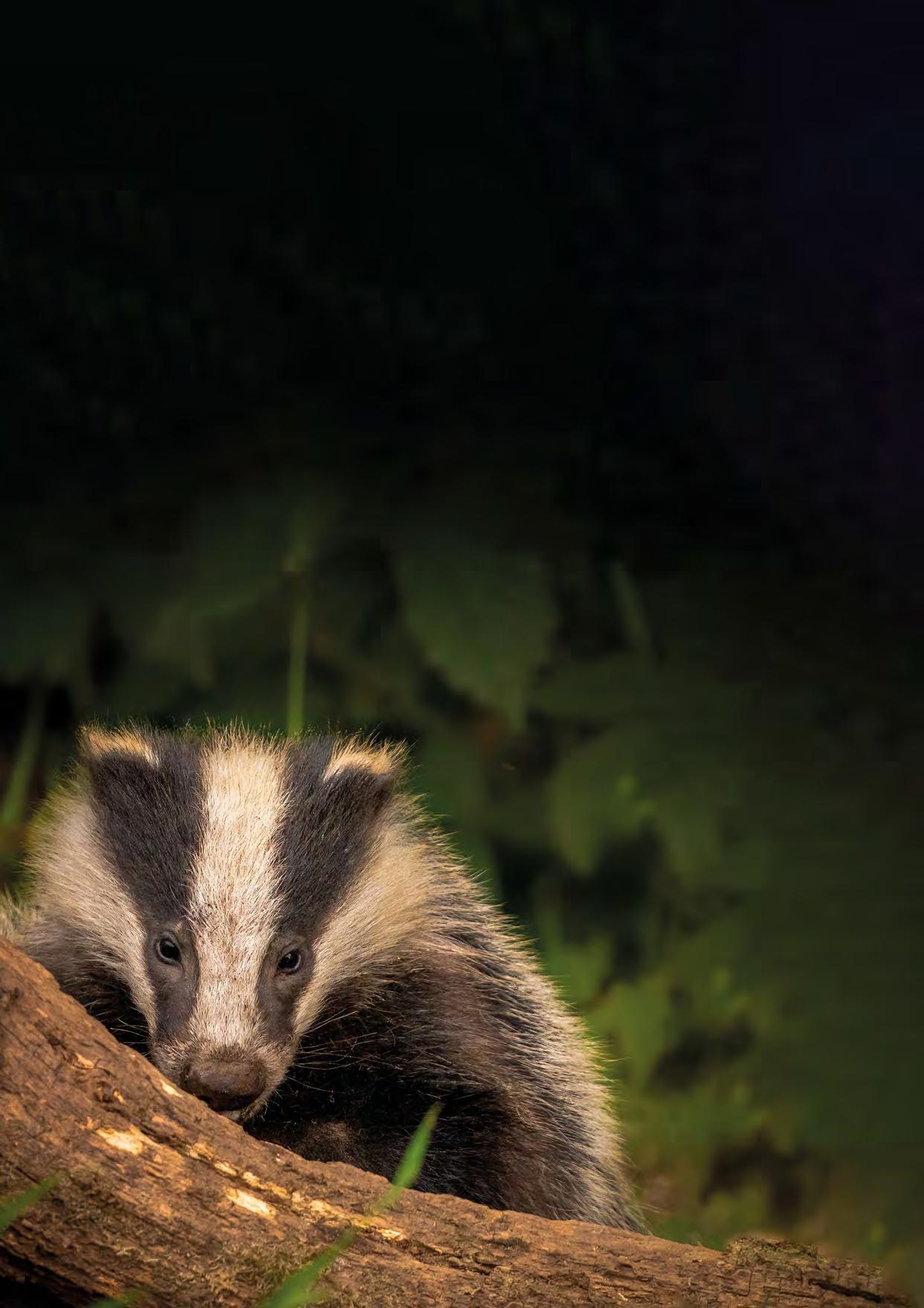
38WILD Winter 2022 |
trust’s ambassadors
Essex wildlife
Badger photo: Paul Browning - instagram: @macro.paul, @paulbrowning.photography
Francesca is a wildlife biologist, presenter and Essex Wildlife Trust Ambassador. Her life-long appreciation for animals has led her to work with them in a variety of settings including in a veterinary practice, a zoo, in sanctuaries and in the wild.
Give the gift of nature
When you adopt a species through Essex Wildlife Trust, you are helping us to continue vital conservation work, protecting wildlife and wild places in Essex.
Adopt an animal yourself, or send it as a gift to a loved one. Visit www.essexwt.org.uk/ adopt-species or scan the QR code above to choose your species.
Keeping owls on the prowl
An elusive bird of prey that roams the open space of the countryside, barn owls need your help. These owls have characteristic heart-shaped faces, cloud-like white chests with mottled brown and grey feathered wings on their back.
In a prickle
Did you know, hedgehogs can roam over 2km in one night? Despite their spiked armour, our nature neighbours aren’t as tough as they seem. In reality, these long-snouted softies are facing rapid decline, but it’s not too late to give them a helping hand.
Hare today, gone tomorrow
This nimble and swift creature has an impressive sprinting speed of 45mph, but can’t outrun the pressures facing wildlife without your help. Ensure that we can enjoy the sight of black-tipped elongated ears hopping through farmland and woodland for years to come.
Love Essex • Love Wildlife Registered Charity No. 210065


heardit’s im-peck-able
Wildlife Explorer podcast delves
the secret lives of some of our best-loved wildlife. nature on the go Discover Love Essex • Love Wildlife Registered Charity No. 210065 Spotify, Apple Podcasts and all other online podcast platforms.
I’ve
The
into
Photo: Jon Hawkins - Surrey Hills Photography
Nature Discovery Centres
After a wintry walk, take a visit to one of our Nature Discovery Centres. We have wild events, activities, gifts, and a fantastic café at each site. We look forward to welcoming you this winter.
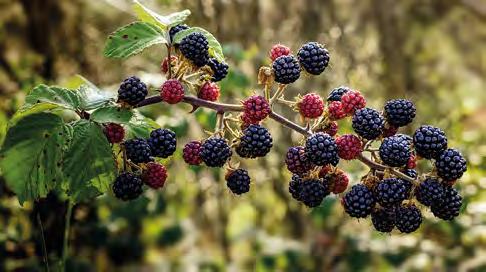
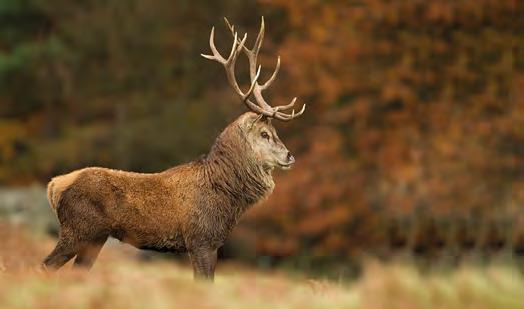
Abberton Reservoir

Abberton
Reservoir Nature Discovery Park
Church Road, Layer-de-la-Haye, Colchester, CO2 0EU 01206 738172 / abberton@essexwt.org.uk
Over the winter months we turn our attention to management work within Wild Wood and our scrub. Coppicing and thinning will help to change the structure of the woodland, attracting a wide variety of insects and other species. For updates on all things Abberton, follow us on Facebook.
Jo
Wray, Site Manager
Bedfords Park
Bedfords Park Nature Discovery Centre
Broxhill Road, Havering-atte-Bower, RM4 1QH 01708 748646 / bedfords@essexwt.org.uk
Enjoy a winter woodland walk with views across to the Kentish hills and westward to London. Wander the undulating hills, through Larch Wood, past wildflower meadows and the fishing lake. Then return to the hilltop to meet the resident red deer. Afterwards, pop into our friendly centre for a tasty patisserie and luxury hot chocolate, while exploring our gift range. The children’s play area is located near the free car park, and the charming Georgian Walled Garden is open Tuesdays, Thursdays and every second Sunday.
Rebecca Porter, Site Manager
Belfairs






Belfairs Nature Discovery Centre

Eastwood Road North, Leigh-on-Sea, SS9 4LR 01702 477467 / belfairs@essexwt.org.uk

After a wonderful summer at Belfairs, we are looking forward to our Christmas festivities. We will be making natural decorations and Santa’s Elf Workshop will be open to all good boys and girls! There will be seasonal guided walks and Lizzie’s wellbeing walks take place every Tuesday and Saturday, free to all. Full details of upcoming events are on our Facebook page.
Greg
Borgartz, Site Manager
Fingringhoe Wick Nature Discovery Park
South Green Road, Fingringhoe, Colchester, CO5 7DN 01206 729678 / fingringhoe@essexwt.org.uk
The nights drawing in are the perfect excuse to get the log fire lit and the centre all cosy! No matter the weather, pop in for coffee and cake, then brave a walk to the estuary to see the huge flocks of waders putting on a stunning display. We are holding wreath and Christmas decoration making events in December and our children’s trail will run each December weekend and holiday day.
Verity Hales, Site Manager
Follow each of our Nature Discovery Centres on Facebook
Nature Discovery Centres
42WILD Winter 2022 |
Fingringhoe Wick
Red deer photo: Danny Green/2020VISION
Discover your nearest centre www.essexwt.org.uk/visit/centres
Hanningfield Reservoir
Hanningfield Reservoir
Nature Discovery Park
Hawkswood Road, Downham, Billericay, CM11 1WT 01268 711001 / hanningfield@essexwt.org.uk
Throughout December you can take yourself around the park, following the map in the hunt for Santa’s Reindeers, who have been busy getting up to mischief. Can you solve the puzzle to help Santa finish his Christmas story? Every first Thursday of the month in support of the Billericay Dementia Action Alliance we are also holding our “Hanners Club” from 2-4pm. We would like to invite anyone living with dementia and a family member, friend or carer to get involved in our range of activities at the centre including crafts, board games and wellness walks. Call the centre to book your place.
Michelle Rayner, Assistant Centre Manager
Langdon
Langdon Nature Discovery Park
Lower Dunton Road, Basildon, SS16 6EJ 01268 419103 / langdon@essexwt.org.uk
The crisp cool air of winter mornings is perfect for a walk at Langdon. Visit our charming gift shop to find sustainable local products, unique Peter Rabbit gifts and exquisite presents for everyone. Our woodland Peter Rabbit trail is a favourite exploration activity for children of all ages. Take a seat in the spacious restaurant to warm yourself up with a toasted panini, homemade soup, and a lovely cup of hot chocolate with a slice of cake. Our new HUB will be available soon, offering workshops and a room to hire for social groups.

Yasmine Ward, Assistant Centre Manager
Ingrebourne Valley
Ingrebourne Nature Discovery Centre
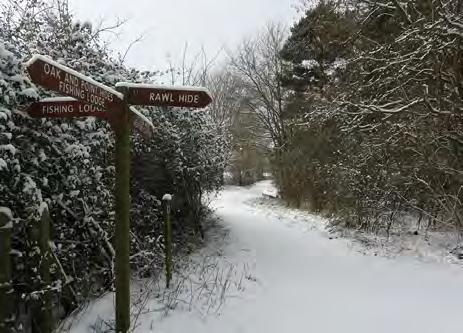



Hornchurch Country Park, Squadrons Approach, RM12 6TS 01708 520364 / ingrebourne@essexwt.org.uk
After an eventful and dry summer, the Ingrebourne Valley has ‘risen from the ashes’ and there is new growth in abundance, with patches of scorched earth now lusher and greener than ever. Nature has a fantastic way of adapting and adjusting to increasing changes. Take time to stop, breathe and wonder at the beautiful nature in the park. Keep up to date with news, photos and events on our Facebook page.
Kate Tyler, Assistant Centre Manager



Thameside Nature Discovery Park


Mucking Wharf Road, Stanford-le-Hope, SS17 0RN 01375 643342 / ttnp@essexwt.org.uk
Over the coming months we will enjoy the migratory waders like black-tailed godwit and greenshank congregating on the mudflats. From the warmth and comfort of our centre you can overlook their feeding grounds and the Thames Estuary. Walk up to the roof terrace for sightings of our resident peregrine falcons, nesting on a redundant riverfront crane! We are also excited to be welcoming Mother Christmas to the park between 17-23 December. Meet Mother Christmas, toast a marshmallow on an open fire, make a crafty decoration and follow a yuletide trail. Book through our website or call the centre.
Jimmy Allan, Site Manager
The
Naze Nature Discovery Centre
Old Hall Lane, Walton-on-the-Naze, CO14 8LE 01255 679379 / naze@essexwt.org.uk
Winter is great for birdwatchers as an influx of migratory birds, including dark-bellied brent geese make The Naze their home for the season. Meanwhile at the centre, we are getting into the Christmas spirit by running adult wreath making workshops and having a Santa’s Grotto, where children can come and receive a gift from Santa himself.
Helen Daw, Assistant Centre Manager
| Nature Discovery Centres 43 WILD Winter 2022
Photo: Max & Kate Tyler
Dark bellied brent geese photo: Chris Gomersall/2020VISION
The Naze
Thameside
Greenshank photo: Bertie Gregory/2020VISION
Winter What’s on this
It’s oh so quiet, the air is crisp, and daylight seems fleeting as the sun takes shortcuts across the sky. Winter has the very important job of taking a county awash with charming autumn sunshine and transforming it into a buzzing spring landscape teaming with new life. In between, Essex becomes a magical scene of sparkling frost and lazy mist, daring you to huff hot breath into the chilly morning air. It’s a massive task and now that the hibernators are tucked up for their post-feast nap, let the transformation begin…
Winter is undeniably the most charming of seasons. So, join the animals by zipping up your own winter coat and venture outdoors. See familiar robins going head-to-head in the hedge, grey squirrels scurrying amongst the branches in a game of kiss chase and estuaries oozing with oystercatchers.
Or partake in what might just be one of our country’s favourite pastimes, watching the ducks. Weather that might seem a bit too cold and drizzly for our liking is paradise for our resident ducks and their overwintering friends. From the striking green, yellow and brown of a male mallard to the black and white tufted duck sporting an eccentric hairdo, there’s plenty of ducks to spot this winter. As ducks can be found almost everywhere including ponds, rivers, reservoirs, estuaries and even out at sea, you don’t have to go far. We’ve created a list of winter waddlers for you to check off as you go, what are you waiting for?
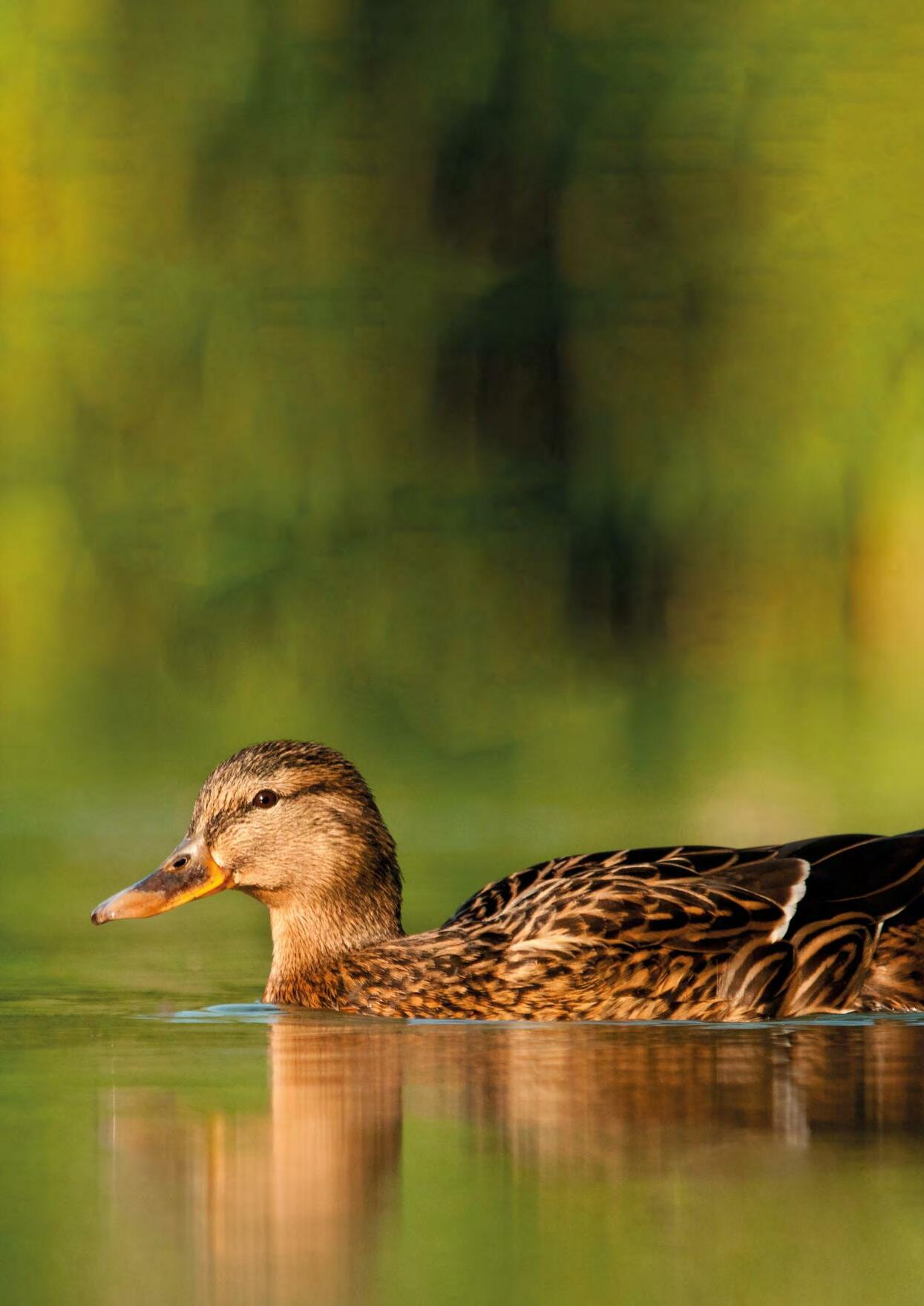
44WILD Winter 2022 | Discover things to do and spot in December, January and February >>>
What’s on this Winter
Winter Species to spot
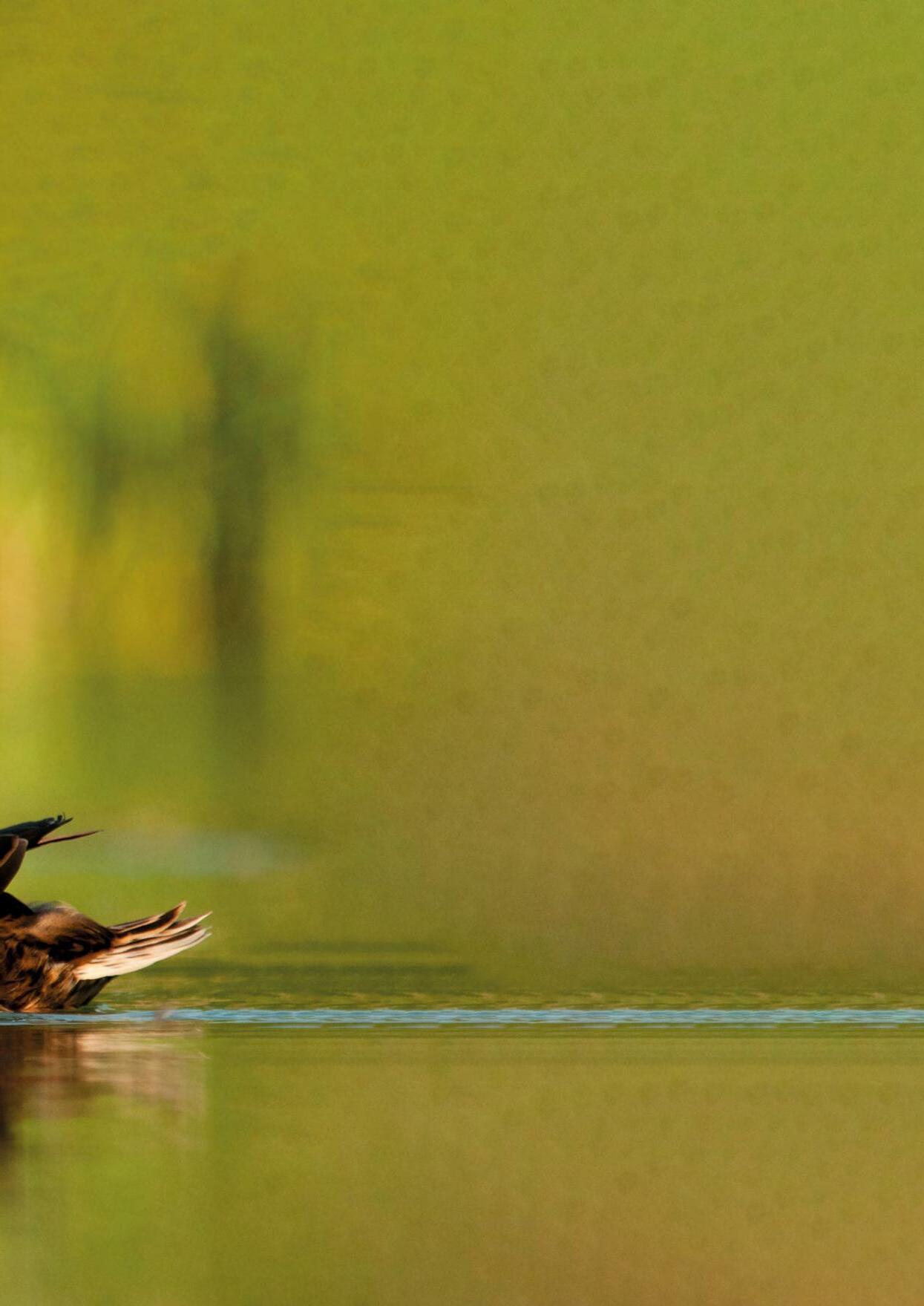
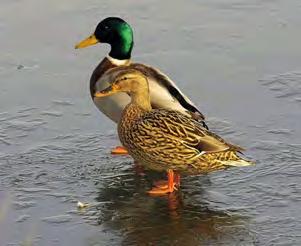








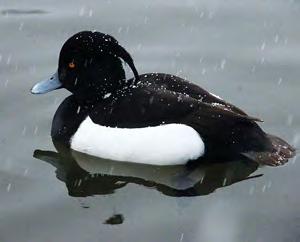


WILD Winter 2022 |
Teal
Pochard
Wigeon
Smew Goosander
Goldeneye
Female mallard background photo: Bertie Gregory/2020VISION
Mallard: Derek Moore, Tufted duck: Paul Thrush, Shelduck: Gillian Day, Gadwall: Derek Moore, Pintail: Derek Moore, Shoveler: Gary Cox, Teal: David Tipling/2020VISION,
What’s on this Winter
Pochard: Guy Edwardes/2020VISION, Wigeon: Danny Green/2020VISION, Goldeneye: Fergus Gill/2020VISION
We’ve created a handy checklist to cut out and keep, featuring some of the dashing ducks you can hope to spot in Essex this winter. Challenge your friends and see how many you can tick off the list whilst enjoying the crisp winter sunshine.
Tufted duck Shelduck
Mallard
Gadwall
Pintail
Shoveler
Children’s Christmas Wreath Making
• Saturday 10 December
• 1pm-3pm
• Thorndon Nature Discovery Centre, CM13 3RZ
A chance for children to come and create their own Christmas wreath using natural materials. £25 per child.
Adult Wreath Making
• Saturday 10 December
• 10am-12pm or 1pm-3pm
• Fingringhoe Wick Nature Discovery Park, CO5 7DN

Weave your own wreath from willow and decorate with natural materials. £25 per person.

Crafty Elf Workshop
• Saturday 17, Sunday 18 & Thursday 22 December
• 9:30am-11am, 1pm-2:30pm, 3pm-4:30pm
• Belfairs Nature Discovery Centre, SS9 4LR

Create Christmas decorations and natural crafts then receive a small gift from Santa himself. £12 per child.
Christmas events
Festive Craft and Forest Trail
• Saturday 10 & 17 December
• 10am-2pm
• Ingrebourne Nature Discovery Centre, RM12 6TS Follow a festive trail, then pop into the centre to make your own Christmas decoration. £5 per child.
Bird Balls
• Saturday 17 December
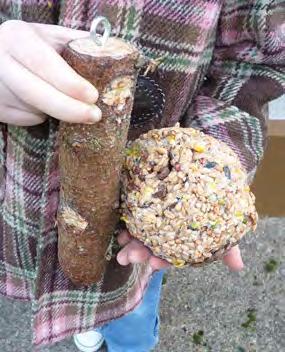
• 10am-12pm or 1pm-3pm
• Bedfords Park Nature Discovery Centre, RM14 1QH Help the birds in your garden by creating your own bird balls, while learning about winter birds. £7 per child.
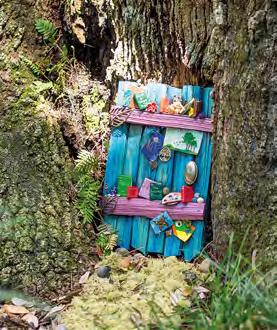
Elf Door Trail
• Saturday 17 December
• 10am-3pm
• Abberton Reservoir Nature Discovery Park, CO2 0EU Santa’s elves have been spotted at Abberton! Open the doors to their magical houses and answer their questions. £4 per child.
Festive Forest Trail
• Friday 23 December
• 10am-3pm
• Hanningfield Reservoir Nature Discovery Park, CM11 1WT
Follow a trail through the wintery woods looking for the Christmas doors. £2 per trail map.

46WILD Winter 2022 |
Winter Events and activities
Discover many more events, find details and book online through our website, www.essexwt.org.uk/events.
Photo: Dawn Dickend
Winter Events and activities
Grab those wellies and waterproofs, we have a packed calendar of events to get closer to nature this winter.

New year events
Wildlife walk: Hornchurch
• Sunday 1 January, 10am-12:30pm
• Hornchurch Country Park
Join Havering Local Group for a stroll around Hornchurch Country Park. The walk will take about two hours, please wear suitable clothing and footwear. Free to attend, meet at Ingrebourne Nature Discovery Centre.
Quiz Night
• Saturday 4 February, 7:30pm-10pm
• Shenfield Parish Hall
Brentwood & Billericay Local Group are hosting their ever-popular quiz night featuring questions for all ages and all abilities. Bring your own snacks and drinks. £10 tickets. Contact John Allen on chainbridge1009@gmail. com or 01277 231305

Illustrated Talk: Tiptree Heath
• Thursday 16 February, from 7:30pm
• The Cygnet Room, Swan Hotel, CM9 5EP
Maldon & South Woodham Ferrers Local Group are hosting an illustrated talk about ‘The History, Culture, and Wildlife of Tiptree Heath’, by reserve warden Joan Pinch. Suggested donation £3.
Winter Walk: Fingringhoe Wick
• Sunday 19 February, from 11am
• Fingringhoe Wick Nature Discovery Park, CO5 7DN
Join Colchester Local Group for a winter walk around the varying different habitats, visit hides to get a close look at the wildlife, while looking out for winter waders and birds of prey. Suggested donation £4, contact 07963080335 or pjcatte@gmail.com
The Cinderella Habitat
• Tuesday 21 February, from 7:15pm
• St Andrews Church Hall, CO9 2LD Braintree Local Group are hosting a talk on The Cinderella Habitat – Peatlands, Planetary Warming and Paludiculture by Richard Lindsay. Find out what peatlands do for us and the restoration projects that will assist in combating climate change and biodiversity loss. Suggested donation £3.
Tendring Local Group AGM
• Thursday 23 February, 7:30pm-9:30pm
• The Naze Nature Discovery Centre, CO14 8LE
Verbal and written reports on the group’s activities, income, and expenditure, followed by a talk from the Trust’s Director of Conservation, Jez Dagley
47 WILD Winter 2022 |
Peatland
photo: Rob Jordan/2020VISION
David Oakes Ancient trees
You start by entering your postcode. A few moments later you’re rewarded with a map. Your home at the epicentre, with every veteran, ancient, and potentially superstar tree marked accordingly, radiating outward from your front door. This is the Ancient Tree Inventory.


My map shows the remains of the medieval village of Marsden. My oldest neighbour is Tree #158744 — simply “’44” to me. It’s a pedunculate oak, over 6.5 metres in girth and easily 500 years old. Maybe 600. Maybe more… Chances are that it is the last living survivor of long-lost Marsden.
Type in your postcode and you may discover you live next to one of hundreds of ‘celebri-trees’: perhaps the Tolpuddle Martyrs’ sycamore that birthed the Trade Union movement? Or maybe John Evelyn’s black mulberry, supposedly planted by Tsar Peter I as an apology for his drunken antics! Who knows what these trees really saw, but what’s important is that they remain.
A tree isn’t just one organism, it’s a metropolis for life. My Marsden oak can support well over 1,000 species: birds, mammals, invertebrates, lichens, fungi, bryophytes… Every nook of our nation’s biodiversity. In fact, the pedunculate oak supports more unique species than any other of our native trees. And the longer they stay in the ground, the more interconnected they become with the life they support. The late, great, Oliver Rackham said: “Ten thousand oaks of one hundred years are no substitute for one five-hundred-year-old oak tree.”
Our ancient trees are often found within ancient forests that have existed since our very first maps. Some could stretch back as
far as the last ice age. Ever since, they have nurtured dense biological multi-species interactions. Without them, we’re just dusty skeletons living in housing estates. This summer, wildfires exacerbated by human behaviour burned across the globe and parts of the UK reached unprecedented temperatures of over 40 degrees. Ironically, the shade of a tree may be your best bet at remaining cool. Through transpiration, the area beneath a tree remains degrees cooler than a similar area shaded by a man-made structure. But even as the country cooked, bulldozers were poised to tear down ancient trees for the government’s high speed rail link.
The Cubbington Pear Tree, #74902 on the Ancient Tree Inventory, was voted the 2015 “Tree of the Year”. Over 250 years old, it was then the second oldest wild pear in the country, possessing a girth of almost four metres. Pear trees’ fruit and blossom harbour abundant mammal, bird, and invertebrate life. This tree, and the biodiversity it homed, was destroyed in October 2020 so that Birmingham could become 12 minutes closer to London. On the Ancient Tree Inventory, the Cubbington Pear Tree is now simply marked as “Lost”.
Every tree lost is a blow to nature. Every ancient tree lost expedites the collapse of our nation’s biodiversity. We have to protect these ancient treasures.
PUTTING TREES ON THE MAP
The Ancient Tree Inventory is run by The Woodland Trust and maps over 180,000 of the oldest and most important trees in the UK. You can explore the trees near you, or add your own special trees, at ati.woodlandtrust.org.uk
Construction work for HS2 continues to damage and destroy irreplaceable habitats. Find out more and how you can help at wildlifetrusts.org/hs2
David Oakes is an actor, podcaster, and ambassador for The Wildlife Trusts. When he’s not on set or treading the boards, he’s out walking in a glorious wild place talking to experts about the natural world and celebrating it in his podcast, Trees A Crowd

ILLUSTRATION © SEÁN RYAN / WWW.THESHAMANSHORSE.COM.
OAKES HEADSHOT © GRAHAM MAKEPEACE-WARNE
DAVID
Wild thoughts 48 WILD Winter 2022 |
@David_Oakes@doakesdoakes



Play Discover Learn Play Discover Learn Play Discover Learn Play Discover Learn Welcome to the Nature Nursery. We offer quality childcare for 2-5 year-olds based on learning through nature. Come along and experience a morning at our outdoor nature nursery. Take a look at our upcoming open days and book a spot: Nature Nursery is part of: Happy, healthy and hungry to learn. Set in the grounds of Abbotts Hall near Colchester, where children can enjoy both freedom and security, our outdoor nursery is run by early learning experts at Essex Wildlife Trust, the most experienced provider of outdoor education in the county. Registered Charity Number 210065 Photos: Eleanor Church / Lark Rise Pictures www.naturenursery.org.uk
Towns, Villages Wilder Wilder
We need to see wildlife spilling out from the boundaries of our nature reserves and expanding across our landscape, which Essex Wildlife Trust cannot do alone. This summer, we launched our Wilder Towns, Wilder Villages project, to recruit parish and town councils across the county to take action for wildlife in their parks, gardens, allotments, green spaces, open spaces and urban sites.
After signing up to be part of the programme, the Trust works with councils to share expertise and offer bespoke guidance, site visits are held with Trust experts and staff have been attending parish council meetings. Next year, a programme of webinars and workshops will be available to support councils to take measurable steps to create, protect and enhance habitats for wildlife.
We now have 15 parish or town councils who are working towards our vision of a Wilder Essex, and we’re looking forward to working with more in the new year.
Operations Manager Terry Frostick is leading his council on a mission to wild up road verges and green spaces. Initial actions are taking place in Lime Avenue recreational grounds, where grassland management cycles, natural regeneration and hedge planting are being used to increase the quantity of habitats available.



Councillor Sandra Douglas and Clerk to the Council Helen Waterfield are setting in motion a vision of a wilder Black Notley. With Essex Ecology, the Trust’s ecological consultancy, the council are looking to improve habitat quality and availability across two sites, Millennium Green and Cokers Peace.
Councillor Jane Williams and Clerk to the Council Lorraine Bailey are working alongside the Wickham Bishops Biodiversity project to make the village wilder. In collaboration with John, an Urban Wildlife Champion, multiple projects are already underway such as the creation of a native wildflower meadow on Rainbow Fields in partnership with the Sports Association.
Saffron Walden
Black Notley
50WILD Winter 2022 | WILDER TOWNS, WILDER VILLAGES
Wickham Bishops
Clerk to the Council, Mark Hembury, and Councillor Angie Faulds are hoping to work across Broomfield from woodland management to natural regeneration and grassland habitat creation. Initial action will take place along Church Green and Parsonage Green.

Councillor Diane Wallace and Ted Munt are working alongside our Urban Wildlife Champion, Donna, to enhance Stonepath Community Open Space. Various strategies such as hedge planting and grassland management are now being used to wild the area.




Councillor Alison Howells, alongside other members of the council and Wild Thaxted have an ambition of increasing the floral diversity on Mosscotts Meadow and across two other trial sites. Action has already been taken to widen and manage a new hedgerow.

Councillor Sue Green and Councillor India Jayatillake are working together to increase the variety of native floral species in Brockwell Meadows nature reserve, on the boundaries of the Blackwater river.


Scan
QR code
Wilder Towns Wilder Villages
Broomfield
thaxted
51 WILD Winter 2022|
WILDER VILLAGES
kelvedon
WILDER TOWNS,
Do you want your council to lead changes like these in your town or village?
the
below to find out how you can make this happen:
hatfield peverel
ecaying trunks, rotting stumps, and fallen trees are all in hot demand. This prime real estate is home to a huge variety of wildlife. There’s a fantastic range of properties in our deadwood portfolio, from the high-rise to the sprawling single-storey. These habitats all play an important role in the nutrient cycle, help to lock up carbon, and even improve the stability of our soils. Interested in seeing the particulars? Then let’s go on a viewing and get to know the neighbourhood!


There’s a busy market for deadwood dwellings!
STAG BEETLE © TERRY WHITTAKER/2020VISION, WOODEN SIGN © SITTIPONG_SRIKANYA, ISTOCK
Rot property WILD Winter 2022 | 52
Chloë Edwards is director of nature recovery at Herts & Middlesex Wildlife Trust. Chloë is a deadwood enthusiast and loves marvelling at the life in the various deadwood features she’s nurtured in her garden.
Family-friendly environment
Neighbourhoods rich in dead and decaying wood are home to incredibly diverse communities. Many of the residents are invertebrates and fungi that play an important role in breaking down wood. A lot of them are entirely dependent on dead or decaying wood for at least part of their life cycle — we call this saproxylic. Some of our most recognisable insects are saproxylic.
The larvae of the majestic stag beetle favour basement locations in underground deadwood, whilst black and yellow longhorn beetle larvae are long-term tenants of fallen branches, taking up to three years to leave their home as adults. Finding the ideal location for a young family is also high on the house-hunting agenda for the batman hoverfly. It seeks out rot holes in trees where wet, decaying wood makes an ideal nursery. Fungi that thrive in these locations range from the delicate stalks of candlesnuff fungus to the chunky chicken of the woods.

Location, location, location…

A third of all woodland birds nest in the hollows or cavities of dead trees. Great spotted woodpeckers drill their own holes, whilst nuthatches and tawny owls seek out existing gaps. Other birds of prey will use standing dead trees as a lookout post, or for somewhere to devour their prey.
Many of our bat species search for trees with lots of character (cavities, rot holes, fissures, and splits) in which to roost. Our biggest bat, the noctule, isn’t put off by a pre-loved home. They often favour old woodpecker holes. The rare and elusive barbastelle bat, found only in woods with plenty of standing deadwood, often takes advantage of spaces behind lifted, flaky bark plates.
They are not alone in the vertebrate community in finding deadwood attractive. Through the seasons, many amphibians and reptiles will be taken with the charm of a log pile. Its amenities include shelter, a lookout point, somewhere to bed down, a sun lounger, and so many opportunities for eating out right on the doorstep — deadwood has it all!
On the water
It’s not just land-lovers who appreciate deadwood. Fallen logs in rivers can provide the perfect refuge for fish and a whole host of aquatic invertebrates. They can also be a spraint spot for an otter, or a perch for a kingfisher. They even act as natural dams and can slow the flow of a river or stream, reducing erosion and holding water back in times of heavy rain, helping to make the landscape more resilient.
Your next move

With 13% of all plants and animals known in the UK directly dependent on deadwood habitats, it’s a vital component of our landscapes. We must respect it, protect it, and seek to create more of it! Make a garden more appealing by creating a log pile. If you have a tree stump in the garden, leave it for your new wild neighbours to move into. Pop out the welcome mat and wait to see who turns up to the housewarming!
tips on making a deadwood dwelling visit wildlifetrusts.org/log-shelter

53 WILD Winter 2022|
STAG BEETLE LARVAE © JANE BURTON, NATUREPL.COM; LOG PILE © SCOTT PETREK; FALLEN SCOTS PINE © MARK HAMBLIN/2020VISION; NUTHATCH © NEIL ALDRIDGE
For
Rot property 2022 |
NICK UPTON
You made the government give a dam!
ngland has taken a few tentative steps towards seeing a return of beavers to the wild, following new legislation announced by Defra. The legislation will provide legal protections for beavers in England, making it an offence to deliberately capture, kill, disturb, or injure beavers, or damage their breeding sites or resting places, without holding the appropriate license. The legislation is scheduled to come into force in the autumn.
These new protections could pave the way for beavers to be released into the wild in England under license, finally making a widespread comeback after being hunted to extinction in the 16th century. This decision echoes the path taken in Scotland, where beavers were declared a European Protected Species in 2019, affording them similar protections to those proposed in England.
The legislation was initially due to be laid in parliament on the 19th of July, but the UK Government held it up at the last minute. Following outrage from nature charities and the wider public, including lots of Wildlife Trust supporters, the decision was reconsidered and the announcement made just a few days later.
Beavers are ecosystem engineers. Their actions create thriving and dynamic wetlands that bring a wealth of benefits to both nature and people, including playing a critical role in adapting to a changing climate. Long-term studies of beavers from the Scottish Beaver Trial and in enclosures in England have demonstrated the improvements they can bring to our rivers and wetlands, making it clear that beavers belong in our landscape.
Commenting on the UK Government’s decision, The Wildlife Trusts’ chief executive Craig Bennett says: “The widespread return of wild beavers can be a game changer for restoring lost wetlands, benefitting all kinds of wildlife, and helping people by holding water back in the landscape, reducing the risk of wildfires and reducing the risk of flooding downstream. Bringing back wild beavers isn’t just a dream, it is a critical part of addressing the climate and nature crises.”
Whilst The Wildlife Trusts believe bringing back beavers is essential, reintroducing any ecosystem engineer is a delicate operation. Natural England is developing guidance on the management of beavers, setting out the actions that will or will not require a license. We are urging the UK Government to support ambitious and carefully targeted reintroduction projects, reward landowners who make space for wetlands created by beavers, develop management systems that protect beavers and resolve issues effectively, and support local beaver management groups to deliver advice and assistance.
The news of this legislation came as Wildlife Trusts around England celebrated the birth of beaver kits at enclosed projects on nature reserves. The Welsh Beaver Project, led by Wildlife Trusts Wales, also saw its first kit born at an enclosure at Montgomeryshire Wildlife Trust’s Cors Dyfi nature reserve.
Get the latest on our journey to bring beavers back to Britain at wildlifetrusts.org/saving-species/beavers
The beaver comeback
2001
Kent Wildlife Trust bring the first beavers back to Britain in an enclosure at Ham Fen.
2009
First beavers officially released into the wild by the Scottish Beaver Trial.
2014
Beavers discovered living wild on the River Otter in Devon. Devon Wildlife Trust begin England’s first wild beaver trial.

2017
The Scottish Beaver Trial release more beavers to reinforce the population.
2019
Beavers designated a European Protected Species in Scotland.
2020
Beavers allowed to stay on the River Otter.
2021
Wildlife Trusts release a record number of beavers (17) into fenced areas across the Britain.
2022
Legislation announced to make beavers

UK NEWS UK UPDATE SWIMMING BEAVER © RUSSELL SAVORY; STANDING BEAVER
©
54WILD Winter 2022 UK News |
Beavers are making a comeback across the UK
Crisis calculations
The Wildlife Trusts have published a groundbreaking report examining the projected impacts of climate change on our nature reserves. It assesses the risks of a changing climate and what we need to do to help nature adapt. The report shows that extreme weather is already affecting many nature reserves through wildfires, flooding, and drought. Research
finds that by the 2050s, half of our nature reserves will have 30+ days of very high fire risk a year, and 55% will see nearby river flows drop by more than 30% during times of low flow. The report also shares innovative Wildlife Trust projects that aim to reduce the impacts on wildlife. Read the report at wtru.st/changing-nature


The Queen
Queen Elizabeth II was celebrated for
passion for the outdoors, the countryside and rural life, lending her support to the work of The Wildlife Trusts and many environmental charities over the years. The Wildlife Trusts are proud to have been a part of Coronation Meadows — an inspirational idea to mark the 60th anniversary of The Queen’s Coronation in 2013. These meadows will stand as a lasting natural legacy. So far, 90 new meadows have been created, including…
Eyecott Hill, Cumbria
Meadows at Cumbria Wildlife Trust’s Eycott Hill nature reserve were brought to life with traditional Cumbrian hay meadow flowers and grasses. The restored meadows have provided inspiration for textile arts project for adults with learning disabilities and older people with dementia.
Fir Grove, Norfolk Roadside verges hold some of the last fragments of Norfolk’s flower-rich meadows, providing a seed base to create farmland meadows once more. Norfolk Wildlife Trust volunteers helped harvest green hay from a roadside nature reserve to create the seven acre Coronation Meadow at Fir Grove.
Dunchurch Meadow, Warwickshire
This new meadow was strewn with green hay harvested from Warwickshire Wildlife Trust’s Draycote Meadow reserve, where up to 20,000 green-winged orchids bloom. Many new flowers have become established at Dunchurch, including green-winged orchids.
 SCORCHED RESERVE © ADAM BOULTON SURREY WILDLIFE TRUST. GREEN-WINGED ORCHID
© ANDY BARTLETT
Wildfires are becoming more common due to climate change
her
REMEMBERING HER MAJESTY
SCORCHED RESERVE © ADAM BOULTON SURREY WILDLIFE TRUST. GREEN-WINGED ORCHID
© ANDY BARTLETT
Wildfires are becoming more common due to climate change
her
REMEMBERING HER MAJESTY
55 WILD Winter 2022 UK NEWS |
Water levels dropped dangerouly low at Baitings Reservoir during one of the hottest UK summers on record in 2022
We travel back to...

1994 1994
What was happening globally in 1994:
• Nelson Mandela became president of South Africa.
• The Channel Tunnel was officially opened by Queen Elizabeth II linking England to France.
• The National Lottery launched.
• The first genetically engineered food product, a tomato, was approved by the FDA.
• The Lion King hit cinema screens.
This year, we celebrated the one year anniversary since we re-opened Langdon’s sustainable Nature Discovery Centre. Here, we look back at Essex Wildlife Trust’s Autumn 1994 magazine, when the ambition to create a ‘gateway to nature’, was first introduced.


A better future for wildlife
The Trust needs the support of the people of Essex, who understand and appreciate the wildlife and the countryside. Gordon Reid, chairman of Basildon Natural History Society, explains why Langdon nature reserve is an ideal area to foster this, and how a conservation centre there will be the gateway for many more people to learn about, enjoy and protect the wildlife around them.
Langdon is a wonderful mixture of habitat; ancient and secondary woodlands, large ‘unimproved’ meadows superbly rich in wildflowers, many ponds and lakes and overgrown former plotland gardens. The woodlands contain a rich variety of trees; oak, ash, hornbeam, field maple, wild cherry and many wild service trees. The reserve is home to 60 species of breeding birds and 27 species of butterflies. The whole area is criss-crossed with a network of 18 miles of footpaths and bridleways.

The reserve also has important historical links. Megalithic flints have been found and some of the flower-rich hay meadows are a former ancient deer park with the original hedge lines still in place. Much of the reserve was formerly Plotlands - hundreds of bungalows and chalets built between the turn of the century and 1940 by people from London, as weekend retreats or as home for those coming out to seek a new self-sufficient life. The Haven, a plotland bungalow built in the 1930s, is furnished with items from this period and it is now used as a museum.
The new conservation centre at Lower Dunton Road at the foot of the Langdon Hills will be a gateway to people’s appreciation of this superb countryside. It will enable the Trust to host properly the many school parties and other visitors who will come to study not only the natural history and wildlife of the area but also the important local social history of the first half of the twentieth century.
Visitors to Langdon will see not just its wildlife rarities, of which it has its fair share, but abundant wildlife once common in our countryside but now threatened in the country by intensive farming and urban development. Their understanding will lead to more support for the work of the Trust.
56WILD Winter 2022 |
...to give you a glimpse of our past and see what was happening at the Trust.
Time Tunnel
Original draft plan for Langdon’s first conservation centre
Langdon’s new discovery centre
See how far we have come since 1994 and visit Langdon’s brand new centre!





Peartree Road, Stanway, Colchester, Essex CO3 0LA 01206 765444 www.hatfields.com Tag us on Social Media #HatfieldsAtHome GEORGETOWN Reclaimed Pine Dining Furniture SUSTAINABLY Stylish HOME FURNISHINGS STARTS27th December Made with many natural & recylable materials HABBERLEY CARPET ECO Concious Flooring Opal ECO Sofa Collection
smallest group of bats in Europe. (11)
name for a badger or an otter’s toilet area. (7)
There are approximately 20 species of Galanthus, commonly referred to as a ___. (8)
After successfully breeding in Norfolk, which bird of prey is now spotted across coastal Essex. (5,7)

Japanese bullet trains were modelled after this bird’s beak. (10)
Which marine mammal breeds between October-January. (4,4)
This butterfly has two bright eye spots and hibernates as an adult over winter. (7)
Clues down
What is an eel referred to, before it becomes a mature adult? (5)
When either of Earth’s poles reaches its maximum tilt away from the Sun, this day is called the ________, ____________. (6,8)

Frogs lay their eggs in clumps, which amphibian lays their eggs in strands? (4)
Largest species of duck in the UK. (8)

58WILD Winter 2022 | Wildlife quiz time How is your general knowledge on wildlife and the wild places of our country? Test yourself with our nature crossword. The answers will be revealed in our Spring 2023 edition of WILD Wildlife fun facts... Answers from Autumn 2022: Across: 3. Jelly ear 5. Brook lamprey 7. Cuckoo 8. Pollination 9. Spoonbill 11. Sea lavender 12. Red kite Down 1. Tawny 2. Harbour porpoise 4. Grass 6. Red 10. Jay Noisy fungi Scarlet elf cups are a bright red, cupshaped fungus, which make a ‘puffing’ sound when they release spores. Mad March hares It’s not males that box each other, it’s a fed-up female, boxing away a male who is being too persistent. Devil’s-bit-scabious A frightening sounding name. But this beautiful teasel has the endearing colloquial name of ‘bobby bright buttons’. Devil’s-bit-scabious
1 1 A A A A A A A A A A A A A A A 3 3 A A A A A A 2 1 A 1 3 A 4 A A 1 5 A A A A A 3 A A A 6 4 A 4 A A A 5 A A 5 6 A 7 A A A A A 7 A A A A 9 A 10 A A A A A A A 8 A A A 11 A 12 10 A A A A 10 10 A A A A A A A A A A A A 11 11 11 A A A A A A A A A A A A A A A A A A A A A A A A A A 4 A A A A A A A A A A A A A A A A A A A A A Billie’s Wildlife Crossword A 3 2 5 6 9 10
3
5
6
7
8
9
10
12
1
2
4
photo: Amy Lewis 11
Mad march hares photo: Russell Savory 12
Noisy fungi photo: Guy Edwardes/2020VISION
Clues Across
The
The
Our largest newt species, resembling a dragon. (5,7)


Scan the QR code to donate today WE NEED your help to protect the iconic species of Essex However, these amazing birds are in serious trouble… to 70085 to donate £5 to 70085 to donate £10 to 70085 to donate £20 SPECIES 5 SPECIES 10 SPECIES 20 TEXT 98% of turtle doves and 92% of nightingales have been lost in the UK since 1970. Save our species The rhythmic song of the nightingale and the soft purring of a turtle dove are well documented throughout history – inspiring poets, authors and musicians alike. For many people, the mesmerising notes of these iconic birds evoke happy childhood memories of long, lazy spring and summer days. Love Essex • Love Wildlife Texts will cost the donation amount plus one standard network rate message, and you’ll be opting into hearing more from us. If you would like to donate but don’t wish to hear more from us, please text SPECIESNOINFO with your donation amount to 70085 instead. Registered Charity No. 210065. All money raised will help Essex Wildlife Trust to protect the iconic species of Essex and the habitats they live in. Thank you for your support. Donate online at www.essexwt.org.uk/save-our-species
Photo: Nightingale.
























 Harry Smith Warden
Harry Smith Warden



 Bailey Tait Campaigns Officer
Bailey Tait Campaigns Officer









































































































































































 SCORCHED RESERVE © ADAM BOULTON SURREY WILDLIFE TRUST. GREEN-WINGED ORCHID
© ANDY BARTLETT
Wildfires are becoming more common due to climate change
her
REMEMBERING HER MAJESTY
SCORCHED RESERVE © ADAM BOULTON SURREY WILDLIFE TRUST. GREEN-WINGED ORCHID
© ANDY BARTLETT
Wildfires are becoming more common due to climate change
her
REMEMBERING HER MAJESTY













